Thermal Protection System and Thermal Management for Combined-Cycle Engine: Review and Prospects
Abstract
1. Background Introduction
1.1. Introduction to Hypersonic Aircrafts and Combined Propulsion
1.2. Thermal and Energy Management of Combined Propulsion
1.3. Main Works of the Present Study
1.4. Structure of the Study
2. Thermal Protection of Combined Propulsion System
2.1. Overview
2.2. Latest Research Progress of Passive Thermal Protection
2.3. Latest Research Progress of Active Thermal Protection
2.4. Latest Research Progress of Thermal Barrier Coating
3. Thermal Management of Propulsion Systems
3.1. Overview
3.2. Low-Temperature Systems
3.3. Thermal Control Systems
3.4. Thermal Protection Systems
4. Prospect
4.1. Overview of Future Research Directions
4.2. Specific Directions of Future Researches
- It is necessary to accurately simulate and study the temperature distribution of each component of the propulsion system in the hypersonic flow field so as to ensure that the thermal management of aircrafts can guarantee that the propulsion system is within the temperature envelope.
- Further analyses should be carried out on one-dimensional heat conduction and heat transfer calculation models of fuel oil, lubricating oil, and air, so as to establish accurate one-dimensional heat conduction equations.
- For thermal management of fuel oil, LNG has better heat sink and cooling performance than current hydrocarbon fuels. Since LNG possesses the potential to be applied in thermal management of fuel oil, further researches remain to be conducted on the high cost and high storage space of LNG as a fuel.
- There are currently few studies on oiling channels of fuel and lubricating oil in the propulsion system. One of the focuses of future researches on thermal management of aircrafts is to carry out numerical simulation of the cooling effect of oiling channels of fuel oil and lubricating oil on the propulsion system proposed in previous studies and to optimize the oiling channels based on the simulation results.
4.3. Overall Directions of Future Researches
- In future researches, a model for calculating the energy interaction among the flow paths of air, fuel oil, and lubricating oil should be established, and how the flow paths mutually influence each other should be taken into consideration, so as to improve the accuracy of flow path design. The efficiency of aircraft thermal management should be improved by exploring the optimal design of the flow path network.
- The matching technology and system control strategy of the thermal management system and engine system should be optimized. Real-time and rapid thermal management systems should be studied by optimizing the tree structure and feedback control cycle of thermal management. The efficiency of thermal management systems can be improved by reducing the computational amount of thermal management systems through improving the objective function and parameters of thermal management systems.
- It is important to further study the thermal management model of propulsion systems of hypersonic vehicles during mode transition, and to probe into the thermodynamic calculation model and flow path design of multiple engines working together (e.g., turbine engine with rocket engine, and rocket engine with ramjet) during mode transition.
- Based on the concept of integrated aircraft/engine technology, thermal management of the propulsion system and aircraft thermal management are no longer operated as two independent submodules. Establishing a calculation model coupling the thermal management system of the propulsion system and the aircraft thermal management system will be a significant research focus in the future.
- Current studies are mostly confined to thermal management of various components of the propulsion system, whereas there are few systematic studies on thermal management of the integral propulsion system. One of the indispensable development directions for future researches is to construct and optimize the thermal management model of the integral propulsion system and conduct relevant reliability analyses.
5. Conclusions
- In terms of thermal protection, there are many researches on the coefficient of thermal conductivity of material and the cooling effect that are directly related to heat proof. But there are few researches on practical application such as the fatigue strength of thermal protection system and the mechanical properties. In fact, heat-resistance theory and practical application are one of the indispensable links of the mature and efficient thermal protection system.
- In the contrast, the researches on thermal management are less than on thermal protection. These researches mainly focus on improving the accuracy of subsystem numerical simulation, the design and optimization of the thermal management algorithm, etc. Regarding the transfer and distribution of heat and energy on the full aircraft scale, there are no obvious advances in the design of full aircraft pipeline and oil line based on heat management.
- Because of the thermal problems caused by hypersonic aircraft, in the future researches, it should combine the macro-cooling effect with the mechanism of micro material heat-resistance in thermal protection area and take into account that the processing and spraying methods, together with the reliability of thermal protection system which may affected by other practical situations. It is very significant to have researches on the accuracy improvement of subsystem numerical simulation and the melioration of the foundation of coupling algorithm. In addition, it is also very important to carry out researches into the theory and design of the distribution and coordinate of heat and energy on the full aircraft scale.
Author Contributions
Funding
Acknowledgments
Conflicts of Interest
References
- Tsien, H.S. Similarity laws of hypersonic flows. Stud. Appl. Math. 1946, 25, 247–251. [Google Scholar] [CrossRef]
- Webb, L.D. Characteristics and Use of X-15 Air-Data Sensors; NASA Technical Note; NASA: Washington, DC, USA, 1968.
- Balas, M.J.; Aditya, R.; Doman, D.B.; Franquiz, F. Multivariable direct adaptive stability and command augmentation of an air-breathing hypersonic vehicle. In Proceedings of the AIAA Information Systems-AIAA Infotech@ Aerospace, Grapevine, TX, USA, 9–13 January 2017; p. 1289. [Google Scholar]
- D’onofrio, J. Gas Turbine Engine Control System Having Integral Flight Mach Number Synthesis Method. U.S. Patent 5,394,689, 7 March 1995. [Google Scholar]
- Chai, J.; Smart, M.K.; Forbesspyratos, S.; Kearney, M. Fly back booster design for mach 5 scramjet launch. In Proceedings of the 68th International Astronautical Congress, Adelaide, Australia, 25–29 September 2017; International Astronautical Federation: Paris, France, 2017; pp. 1–11. [Google Scholar]
- Moon, K.H.; Sung, H.G. Performance characteristics of a tbcc engine with turbo-ramjet engine transition mode. J. Korean Soc. Aeronaut. Space Sci. 2016, 44, 116–122. [Google Scholar]
- Slack, F.J.; Basson, M.; Liu, Z.; Ambros, V.; Horvitz, H.R.; Ruvkun, G. The lin-41 RBCC gene acts in the C. elegans heterochronic pathway between the let-7 regulatory RNA and the LIN-29 transcription factor. Mol. Cell 2000, 5, 659–669. [Google Scholar] [CrossRef]
- Varvill, R.; Bond, A. The skylon spaceplane. J. Br. Interplanet. Soc. 2004, 57, 22–32. [Google Scholar]
- Shukla, A.K.; Singh, O. Thermodynamic investigation of parameters affecting the execution of steam injected cooled gas turbine based combined cycle power plant with vapor absorption inlet air cooling. Appl. Therm. Eng. 2017, 122, 380–388. [Google Scholar] [CrossRef]
- Walker, S.; Tang, M.; Mamplata, C. TBCC propulsion for a mach 6 hypersonic airplane. In Proceedings of the 16th AIAA/DLR/DGLR International Space Planes and Hypersonic Systems and Technologies Conference, Bremen, Germany, 19–22 October 2009; p. 7238. [Google Scholar]
- Snyder, C.A.; Espinosa, A.M. Lessons learned during tbcc design for the nasa-afrl joint system study. In Proceedings of the 58th JANNAF Propulsion Meeting, Arlington, VA, USA, 18–22 April 2011; NASA: Washington, DC, USA, 2013. [Google Scholar]
- Kim, H.S.; Yang, W.S.; Choi, J.Y. Sub-orbital hypersonic flight test programs using sounding rockets and small launch vehicles. J. Korean Soc. Aeronaut. Space Sci. 2015, 43, 243–256. [Google Scholar]
- Marley, C.D.; Driscoll, J.F. Modeling an active and passive thermal protection system for a hypersonic vehicle. In Proceedings of the 55th AIAA Aerospace Sciences, Grapevine, TX, USA, 9–13 January 2017; p. 0118. [Google Scholar]
- Balland, S.; Villace, V.F.; Steelant, J. Thermal and energy management for hypersonic cruise vehicles-cycle analysis. In Proceedings of the 20th AIAA International Space Planes and Hypersonic Systems and Technologies Conference, Glasgow, UK, 6–9 July 2015; p. 3557. [Google Scholar]
- Hussain, P.R.; Suradkar, P.P.; Wani, A.M.; Dar, M.A. Retention of storage quality and post-refrigeration shelf-life extension of plum (Prunus domestica L.) cv. santa rosa using combination of carboxymethyl cellulose (CMC) coating and gamma irradiation. Radiat. Phys. Chem. 2015, 107, 136–148. [Google Scholar] [CrossRef]
- Meng, S.; Yang, Q.; Xie, W.; Xu, C.; Jin, H. Comparative study of structural efficiencies of typical thermal protection concepts. AIAA J. 2017, 55, 2476–2480. [Google Scholar] [CrossRef]
- Li, H.W.; Han, F.; Wang, H.C.; Zhou, Z.Y.; Tao, Z. Film cooling characteristics on the leading edge of a rotating turbine blade with various mainstream Reynolds numbers and coolant densities. Int. J. Heat Mass Transf. 2018, 127, 833–846. [Google Scholar] [CrossRef]
- Dong, Y.W.; Li, X.L.; Zhao, Q.; Yang, J.; Dao, M. Modeling of shrinkage during investment casting of thin-walled hollow turbine blades. J. Mater. Process. Technol. 2017, 244, 190–203. [Google Scholar] [CrossRef]
- Dong, Y.; Li, X.; Zhao, Q.; Li, X.; Dou, Y. Geometrical modeling to improve the accuracy of drilled cooling holes on turbine blades. Int. J. Adv. Manuf. Technol. 2017, 93, 4409–4428. [Google Scholar] [CrossRef]
- Adesanya, S.O.; Falade, J.A.; Jangili, S.; Beg, O.A. Irreversibility analysis for reactive third-grade fluid flow and heat transfer with convective wall cooling. Alex. Eng. J. 2017, 56, 153–160. [Google Scholar] [CrossRef]
- Schwanekamp, T. System studies on active thermal protection of a hypersonic suborbital passenger transport vehicle. In Proceedings of the 19th AIAA International Space Planes and Hypersonic Systems and Technologies Conference, Atlanta, GA, USA, 16–20 June 2014; p. 2372. [Google Scholar]
- Lee, K.N. Rare Earth Silicate Environmental Barrier Coatings. U.S. Patent Application 15/408,062, 4 May 2017. [Google Scholar]
- Smialek, J.L.; Miller, R.A. Revisiting the Birth of 7YSZ Thermal Barrier Coatings: Steve Stecura; NASA: Washington, DC, USA, 2017.
- Luo, M.; Luo, H.; Zhang, D.; Tang, K. Improving tool life in multi-axis milling of Ni-based superalloy with ball-end cutter based on the active cutting edge shift strategy. J. Mater. Process. Technol. 2018, 252, 105–115. [Google Scholar] [CrossRef]
- Koch, D.; Mauer, G.; Vaben, R. Manufacturing of composite coatings by atmospheric plasma spraying using different feed-stock materials as YSZ and mosi 2. J. Therm. Spray Technol. 2017, 26, 708–716. [Google Scholar] [CrossRef]
- Tu, N.H.; Tanabe, Y.; Satake, Y.; Huynh, K.K.; Phuoc, L.H. Large-area and transferred high-quality three-dimensional topological insulator bi2-xsbxte3-ysey ultrathin film by catalyst-free physical vapor deposition. Nano Lett. 2017, 17, 2354–2360. [Google Scholar] [CrossRef] [PubMed]
- Zhao, R.; Wan, M.; Han, J.Q. Jj alonso. In Micro-Nano Technology Xvii-xviii-Proceedings of the 17th–18th Annual Conference and 6th–7th International Conference of the Chinese Society of Micro/Nano Technology; World Scientific: Singapore, 2017; 42p. [Google Scholar]
- Sanson, S.F.; Villedieu, N.; Panerai, F.; Chazot, O.; Congedo, P.M.; Magin, T.E. Quantification of uncertainty on the catalytic property of reusable thermal protection materials from high enthalpy experiments. Exp. Therm. Fluid Sci. 2017, 82, 414–423. [Google Scholar] [CrossRef]
- Guo, L.J.; Peng, J.; Wang, H.Q.; Kou, G.; Huo, C.X. Fabrication of w/cu composite coatings by supersonic atmosphere plasma spraying and their anti-ablation performance under oxyacetylene torch. J. Alloy. Compd. 2017, 703, 560–571. [Google Scholar] [CrossRef]
- Zhao, C.; Zhao, M.; Shahid, M.; Wang, M.; Pan, W. Restrained tgo growth in YSZ/nicraly thermal barrier coatings by modified laser remelting. Surf. Coat. Technol. 2017, 309, 1119–1125. [Google Scholar] [CrossRef]
- Padture, N.P. Advanced structural ceramics in aerospace propulsion. Nat. Mater. 2016, 15, 804. [Google Scholar] [CrossRef] [PubMed]
- Glass, D.E.; Capriotti, D.; Reimer, T.; Kutemeyer, M.; Smart, M. Testing of DLR C/C-SiC and C/C for HIFiRE 8 scramjet combustor. In Proceedings of the 19th AIAA International Space Planes and Hypersonic Systems and Technologies Conference, Atlanta, GA, USA, 16–20 June 2014; p. 3089. [Google Scholar]
- Kiser, J.D.; Grady, J.E.; Bhatt, R.T.; Wiesner, V.L.; Zhu, D. Overview of CMC (Ceramic Matrix Composite) Research at the NASA Glenn Research Center; NASA: Washington, DC, USA, 2016.
- Glass, D.E. Hypersonic Materials and Structures; NASA: Washington, DC, USA, 2016.
- Glass, D.E.; Capriotti, D.P.; Reimer, T.; Kutemeyer, M.; Smart, M. Testing of refractory composites for scramjet combustors. J. Propuls. Power 2016, 32, 1550–1556. [Google Scholar] [CrossRef]
- Reimer, T.; Petkov, I.; Koch, D.; Frieb, M.; Dellin, C. Fabrication and characterization of C/C-sic material made with pitch-based carbon fibers. Process. Prop. Adv. Ceram. Compos. VII 2015, 252, 277. [Google Scholar]
- Heidenreich, B.; Koch, D.; Reimer, T.; Klett, Y. C/C-sic sandwich structures for lightweight tps and hot structures. In Proceedings of the 8th European Workshop on Thermal Protection Systems and Hot Structures, Noordwijk, The Netherlands, 19–22 April 2016. [Google Scholar]
- Taddeo, L.; Gascoin, N.; Fedioun, I.; Chetehouna, K.; Lamoot, L.; Fau, G. Dimensioning of automated regenerative cooling: Setting of high-end experiment. Aerosp. Sci. Technol. 2015, 43, 350–359. [Google Scholar] [CrossRef]
- Gokulakrishnan, P.; Joklik, P.; Fuller, C.; Vander, R.; Abrahamson, J. Experimental and modeling investigation of 976 pyrolytic carbon deposition relevant to fuel film cooling in rocket engines. In Proceedings of the 55th AIAA Aerospace Sciences, Grapevine, TX, USA, 9–13 January 2017; p. 1787. [Google Scholar]
- Hainsworth, S.V.; Uhure, N.J. Diamond like carbon coatings for tribology: Production techniques and characterisation methods and applications. Int. Mater. Rev. 2007, 52, 153–174. [Google Scholar] [CrossRef]
- Basore, K.D.; Selzer, M.; Wheatley, V.; Boyce, R.R.; Mee, D.J.; Capra, B.R.; Kuhn, M.; Brieschenk, S. Performance comparison of distributed injection methods for hypersonic film-cooling. In Proceedings of the 20th Ausrtralasian Fluid Mechanics Conference; Australasian Fluid Mechanics Society, Perth, WA, Australia; 2016. [Google Scholar]
- Pisharady, J.C.; Balachandran, P.; Vijayakumar, V. Computational and experimental study on supersonic film cooling for liquid rocket nozzle applications. Therm. Sci. 2015, 19, 49–58. [Google Scholar]
- Fan, C.; Wang, J.; Fan, X. Experimental studies of film cooling in supersonic combustors. In Proceedings of the 21st AIAA International Space Planes and Hypersonics Technologies Conference, Xiamen, China, 6–9 March 2017; p. 2267. [Google Scholar]
- Keller, M.A.; Kloker, M.J.; Olivier, H. Influence of cooling-gas properties on film-cooling effectiveness in supersonic flow. J. Spacecr. Rocket. 2015, 52, 1443–1455. [Google Scholar] [CrossRef]
- Gulli, S.; Maddalena, L.; Brune, A.; Hosder, S. Integrated analysis of reusable thermal protection systems based on variable-transpiration cooling. J. Spacecr. Rocket. 2014, 51, 412–423. [Google Scholar] [CrossRef]
- Brune, A.; Hosder, S.; Gulli, S.; Maddalena, L. Variable transpiration cooling effectiveness in laminar and turbulent flows for hypersonic vehicles. AIAA J. 2014, 53, 176–189. [Google Scholar] [CrossRef]
- Strauss, F.T.; Manfletti, C.; Freudenmann, D.; Witte, J.; Schlechtriem, S. Preliminary experiments on transpiration cooling in ramjets and scramjets. In Proceedings of the 52nd AIAA/SAE/ASEE Joint Propulsion Conference, Salt Lake City, UT, USA, 25–27 July 2016; p. 4968. [Google Scholar]
- Hanquist, K.M.; Alkandry, H.; Boyd, I.D. Evaluation of computational modeling of electron transpiration cooling at high enthalpies. J. Thermophys. Heat Transf. 2016, 31, 283–293. [Google Scholar] [CrossRef]
- Hanquist, K.M.; Boyd, I.D. Limits for thermionic emission from leading edges of hypersonic vehicles. In Proceedings of the 54th AIAA Aerospace Sciences, San Diego, CA, USA, 4–8 January 2016; p. 0507. [Google Scholar]
- Hanquist, K.M.; Boyd, I.D. Computational analysis of electron transpiration cooling for hypersonic vehicles. In Proceedings of the 55th AIAA Aerospace Sciences, Grapevine, TX, USA, 9–13 January 2017; p. 0900. [Google Scholar]
- Hanquist, K.M.; Hara, K.; Boyd, I.D. Detailed modeling of electron emission for transpiration cooling of hypersonic vehicles. J. Appl. Phys. 2017, 121, 053302. [Google Scholar] [CrossRef]
- Mauer, G.; Sebold, D.; Vaßen, R.; Hejrani, E.; Naumenko, D.; Quadakkers, W.J. Impact of processing conditions and feedstock characteristics on thermally sprayed MCrAlY bondcoat properties. Surf. Coat. Technol. 2017, 318, 114–121. [Google Scholar] [CrossRef]
- Caliari, F.R.; Miranda, F.S.; Reis, D.A.P.; Essiptchouk, A.M.; Filho, G.P. Supersonic plasma spray deposition of conicraly coatings on Ti-6Al-4V alloy. J. Therm. Spray Technol. 2017, 26, 880–889. [Google Scholar] [CrossRef]
- Yuan, K.; Zhu, J.; Dong, W.; Yu, Y.; Lu, X.; Ji, X.; Wang, X. Applying low-pressure plasma spray (LPPS) for coatings in low-temperature sofc. Int. J. Hydrogen Energy 2017, 42, 22243–22249. [Google Scholar] [CrossRef]
- Dobbins, T.A.; Allen, A.J.; Ilavsky, J.; Long, G.G.; Kulkarni, A.; Herman, H. Void Populations in Y2O3-Stabilized ZrO2 Coatings Deposited by High Velocity Oxy-Fuel (HVOF) Thermal Spray; Technical Report; NIST: Gaithersburg, MD, USA, 2017.
- Brova, M.J.; Alat, E.; Pauley, M.A.; Sherbondy, R.; Motta, A.T.; Wolfe, T.; Douglas, E. Undoped and ytterbium-doped titanium aluminum nitride coatings for improved oxidation behavior of nuclear fuel cladding. Surf. Coat. Technol. 2017, 331, 163–171. [Google Scholar] [CrossRef]
- Hejrani, E.; Sebold, D.; Nowak, W.J.; Mauer, G.; Naumenko, D.; Vaben, R.; Quadakkers, W.J. Isothermal and cyclic oxidation behavior of free standing mcraly coatings manufactured by high-velocity atmospheric plasma spraying. Surf. Coat. Technol. 2017, 313, 191–201. [Google Scholar] [CrossRef]
- Nowak, W.; Naumenko, D.; Mor, G.; Mor, F.; Mack, D.E.; Vassen, R.; Singheiser, L.; Quadakkers, W.J. Effect of processing parameters on MCrAlY bondcoat roughness and lifetime of APS–TBC systems. Surf. Coat. Technol. 2014, 260, 82–89. [Google Scholar] [CrossRef]
- Chakraborty, A.; Mondal, A.; Bysakh, S.; Dutta, M.; Singh, S.B. Microstructural investigation of galvanized coatings with prior flash coating of copper on DP steels. Surf. Coat. Technol. 2016, 285, 220–226. [Google Scholar] [CrossRef]
- Schmitt, M.P.; Rai, A.K.; Bhattacharya, R.; Zhu, D.; Wolfe, D.E. Multilayer thermal barrier coating (TBC) architectures utilizing rare earth doped YSZ and rare earth pyrochlores. Surf. Coat. Technol. 2014, 251, 56–63. [Google Scholar] [CrossRef]
- Liu, Q.; Choy, K.L.; Wheatley, R. Theoretical and experimental studies of doping effects on thermodynamic properties of (Dy and Y)-ZrO2. Acta Mater. 2016, 114, 7–14. [Google Scholar]
- Beegum, K.A.B.; Paulose, M.; Peter, V.J.; Raphael, R.; Sreeja, V.G.; Anila, E.I. Study on the effect of synthesis temperature on the structural and surface morphological and optical properties of methyl ammonium lead iodide nanoparticles by sol-gel method. IOP Conf. Ser. Mater. Sci. Eng. 2016, 149, 012078. [Google Scholar] [CrossRef]
- Nyden, M.R.; Forney, G.P.; Stoliarov, S.I.; Westmoreland, P.R. New reactive molecular dynamics algorithm for modeling the thermal decomposition of polymers. In The Third Triennial International Aircraft Fire and Cabin Safety Research Conference; Federal Aviation Administration: Washington, DC, USA, 2017. [Google Scholar]
- Gong, S.; Vanevery, K.; Wang, H.; Trice, R.W. Microstructure and thermal properties of inflight rare-earth doped thermal barriers prepared by suspension plasma spray. J. Eur. Ceram. Soc. 2014, 34, 1243–1253. [Google Scholar] [CrossRef]
- Mahade, S.; Curry, N.; Bjorklund, S.; Markocsan, N. Erosion performance of gadolinium zirconate-based thermal barrier coatings processed by suspension plasma spray. J. Therm. Spray Technol. 2017, 26, 108–115. [Google Scholar] [CrossRef]
- Antolino, N.E.; Kirby, G.H. Additive Method Enabling Air Plasma Spray (APS) over a Smooth Surface. U.S. Patent Application 15/076,825, 28 September 2017. [Google Scholar]
- Tailor, S.; Upadhyaya, R.; Manjunath, S.Y.; Dub, A.V.; Modi, A.; Modi, S.C. Atmospheric plasma sprayed 7%-YSZ thick thermal barrier coatings with controlled segmentation crack densities and its thermal cycling behavior. Ceram. Int. 2018, 44, 2691–2699. [Google Scholar] [CrossRef]
- Sokołowski, P.; Łatka, L.; Pawłowski, L.; Ambroziak, A.; Kozerski, S.; Nait-Ali, B. Characterization of microstructure and thermal properties of YCSZ coatings obtained by suspension plasma spraying. Surf. Coat. Technol. 2015, 268, 147–152. [Google Scholar] [CrossRef]
- Carpio, P.; Rayon, E.; Pawlowski, L.; Cattini, A.; Benavente, R.E.; Bannier, M.D.; Sánchez, E. Microstructure and indentation mechanical properties of YSZ nanostructured coatings obtained by suspension plasma spraying. Surf. Coat. Technol. 2013, 220, 237–243. [Google Scholar] [CrossRef]
- Bernard, B.; Quet, A.; Bianchi, L.; Schick, V.; Joulia, A.; Malié, A.; Rémy, B. Effect of suspension plasma-sprayed YSZ columnar microstructure and bond coat surface preparation on thermal barrier coating properties. J. Therm. Spray Technol. 2017, 26, 1025–1037. [Google Scholar] [CrossRef]
- Lai, Q.; Abrahams, R.; Yan, W.; Qiu, C.; Mutton, P.; Paradowska, A.; Soodi, M. Investigation of a novel functionally graded material for the repair of premium hypereutectoid rails using laser cladding technology. Compos. Part B Eng. 2017, 130, 174–191. [Google Scholar] [CrossRef]
- Johnson, D.J.; Niedbalski, N.P.; Ervin, J.S.; Patnaik, S.S. A thermal management system using ammonium carbamate as an endothermic heat sink. Appl. Therm. Eng. 2017, 121, 897–907. [Google Scholar] [CrossRef]
- Rush, B.M.; Thiagarajan, N.; De Bock, H.P.J. Thermal Management System. U.S. Patent Application 14/848,860, 9 March 2017. [Google Scholar]
- Gerdroodbary, M.B.; Fallah, K.; Pourmirzaagha, H. Characteristics of transverse hydrogen jet in presence of multi air jets within scramjet combustor. Acta Astronaut. 2017, 132, 25–32. [Google Scholar] [CrossRef]
- Preuster, P.; Alekseev, A.; Wasserscheid, P. Hydrogen storage technologies for future energy systems. Ann. Rev. Chem. Biomol. Eng. 2017, 8, 445–471. [Google Scholar] [CrossRef]
- Sharifzadeh, S.; Verstraete, D.; Hendrick, P. Cryogenic hydrogen fuel tanks for large hypersonic cruise vehicles. Int. J. Hydrogen Energy 2015, 40, 12798–12810. [Google Scholar] [CrossRef]
- Roberts, R.A.; Decker, D.D. Control architecture study focused on energy savings of an aircraft thermal management system. J. Dyn. Syst. Meas. Control 2014, 136, 041003. [Google Scholar] [CrossRef]
- Roberts, R.A.; Nuzum, S.R.; Wolff, M. Liquefied natural gas as the next aviation fuel. In Proceedings of the 13th International Energy Conversion Engineering Conference, Orlando, FL, USA, 27–29 July 2015; p. 4247. [Google Scholar]
- Roberts, R.A.; Donovan, A.; Nuzum, S.R.; Wolff, M. Impact of high energy pulsed systems on an aircraft’s power and thermal management system. In Proceedings of the 57th AIAA/ASCE/AHS/ASC Structures and Structural Dynamics and and Materials Conference, San Diego, CA, USA, 4–8 January 2016; p. 0672. [Google Scholar]
- Qin, J.; Zhang, S.; Bao, W.; Zhou, W.; Yu, D. Thermal management method of fuel in advanced aeroengines. Energy 2013, 49, 459–468. [Google Scholar] [CrossRef]
- Qin, J.; Cheng, K.; Zhang, S.; Zhang, D.; Bao, W.; Han, J. Analysis of energy cascade utilization in a chemically recuperated scramjet with indirect combustion. Energy 2016, 114, 1100–1106. [Google Scholar] [CrossRef]
- Zhang, S.; Feng, Y.; Jiang, Y.; Qin, J.; Bao, W.; Han, J.; Haidn, O.J. Thermal behavior in the cracking reaction zone of scramjet cooling channels at different channel aspect ratios. Acta Astronaut. 2016, 127, 41–56. [Google Scholar] [CrossRef]
- Bao, W.; Zhang, S.; Qin, J.; Zhou, W.; Xie, K. Numerical analysis of flowing cracked hydrocarbon fuel inside cooling channels in view of thermal management. Energy 2014, 67, 149–161. [Google Scholar] [CrossRef]
- Nakaya, S.; Tsue, M.; Kono, M.; Imamura, O.; Tomioka, S. Effects of thermally cracked component of n-dodecane on supersonic combustion behaviors in a scramjet model combustor. Combust. Flame 2015, 162, 3847–3853. [Google Scholar] [CrossRef]
- Liang, J.; Liu, Z.; Pan, Y. Coupled heat transfer of supercritical n-decane in a curved cooling channel. J. Thermophys. Heat Transf. 2016, 30, 635–641. [Google Scholar] [CrossRef]
- Allmaras, S.R.; Johnson, F.T. Modifications and clarifications for the implementation of the spalart-allmaras turbulence model. In Proceedings of the Seventh International Conference on Computational Fluid Dynamics (ICCFD7), Big Island, HI, USA, 9–13 July 2012; pp. 1–11. [Google Scholar]
- Hanjalic, K.; Launder, B.E. A reynolds stress model of turbulence and its application to thin shear flows. J. Fluid Mech. 1972, 52, 609–638. [Google Scholar] [CrossRef]
- Liu, H.; Liu, W. Thermal–structural analysis of the platelet heat-pipe-cooled leading edge of hypersonic vehicle. Acta Astronaut. 2016, 127, 13–19. [Google Scholar]
- Jing, T.; He, G.; Li, W.; Qin, F.; Wei, X.; Liu, Y.; Hou, Z. Flow and thermal analyses of regenerative cooling in non-uniform channels for combustion chamber. Appl. Therm. Eng. 2017, 119, 89–97. [Google Scholar] [CrossRef]
- Taddeo, L.; Gascoin, N.; Chetehouna, K.; Ingenito, A.; Gamma, F.; Bouchez, M.; Le Naour, B. Experimental investigation of fuel cooled combustor. In Proceedings of the 52nd AIAA/SAE/ASEE Joint Propulsion Conference, Salt Lake City, UT, USA, 25–27 July 2016; p. 5071. [Google Scholar]
- Sobel, D.R.; Spadaccini, L.J. Hydrocarbon fuel cooling technologies for advanced propulsion. In Proceedings of the ASME 1995 International Gas Turbine and Aeroengine Congress and Exposition, Houston, TX, USA, 5–8 June 1995; American Society of Mechanical Engineers: New York, NY, USA, 1995; p. V003T06A041. [Google Scholar]
- Taddeo, L.; Gascoin, N.; Chetehouna, K.; Ingenito, A.; Stella, F.; Bouchez, M.; Le Naour, B. Experimental Investigation of Fuel-Cooled Combustor: Cooling Efficiency and Coke Formation. In Proceedings of the 21st AIAA International Space Planes and Hypersonics Technologies Conference, Xiamen, China, 6–9 March 2017; p. 2126. [Google Scholar]
- Doman, D.B. Rapid Mission Planning for Aircraft Thermal Management. In Proceedings of the AIAA Guidance, Navigation, and Control Conference, Kissimmee, FL, USA, 5–9 January 2015; p. 1076. [Google Scholar]
- Smith, F.; Massina, C. L-8: Non-Venting Thermal Control Systems for Space Vehicles: Boilerplate; NASA: Washington, DC, USA, 2016.
- Crow, A.J.; Boyd, I.D.; Brown, M.S.; Liu, J. Thermal radiative simulations and measurements of a scramjet test rig. J. Propuls. Power 2014, 30, 1543–1550. [Google Scholar] [CrossRef]
- Lockwood, F.C.; Shah, N.G. A new radiation solution method for incorporation in general combustion prediction procedures. Symp. (Int.) Combust. 1981, 18, 1405–1414. [Google Scholar] [CrossRef]
- Mercier, R.; Cailler, M.; Fiorina, B. Les simulation of the cambridge stratified flame using optimized virtual mechanisms. In Proceedings of the 55th AIAA Aerospace Sciences, Grapevine, TX, USA, 9–13 January 2017; p. 0606. [Google Scholar]
- Chen, T.; Xu, M.; Zeng, S.R.; Quan, E.Q.; Liu, L. The effect of thermal conduction and radiation on the aerodynamic heating of a blunt body. In Proceedings of the 21st AIAA International Space Planes and Hypersonics Technologies Conference, Xiamen, China, 6–9 March 2017; p. 2191. [Google Scholar]
- Myong, H.K.; Kasagi, N. A new approach to the improvement of k-ε turbulence model for wall-bounded shear flows. JSME Int. J. Ser. 2 Fluids Eng. Heat Transf. Power Combust. Thermophys. Prop. 1990, 33, 63–72. [Google Scholar] [CrossRef]
- Larsson, J.; Laurence, S.; Bermejo-Moreno, I.; Bodart, J.; Karl, S.; Vicquelin, R. Incipient thermal choking and stable shock-train formation in the heat-release region of a scramjet combustor. Part II: Large eddy simulations. Combust. Flame 2015, 162, 907–920. [Google Scholar] [CrossRef]
- Park, G.I.; Moin, P. An improved dynamic non-equilibrium wall-model for large eddy simulation. Phys. Fluids 2014, 26, 37–48. [Google Scholar] [CrossRef]
- Zhou, X.; Luo, K.H.; Williams, J.J.R. Numerical studies on vortex structures in the near-field of oscillating diffusion flames. Heat Mass Transf. 2001, 37, 101–110. [Google Scholar] [CrossRef]
- Bricalli, M.G.; Brown, L.M.; Boyce, R.R. Numerical investigation into the combustion behavior of an inlet-fueled thermal-compression-like scramjet. AIAA J. 2015, 53, 1740–1760. [Google Scholar] [CrossRef]
- Gehre, R.; Wheatley, V.; Boyce, R. Combustion regimes in inlet-fulled and low compression scramjets. In Proceedings of the 20th AIAA International Space Planes and Hypersonic Systems and Technologies Conference, Glasgow, UK, 6–9 July 2015; p. 3507. [Google Scholar]
- Loyer, J.L.; Henriques, E.; Fontul, M.; Wiseall, S. Comparison of machine learning methods applied to the estimation of manufacturing cost of jet engine components. Int. J. Prod. Econ. 2016, 178, 109–119. [Google Scholar] [CrossRef]
- Vanyai, T.; Bricalli, M.; Sopek, T.; Brieschenk, S.; McIntyre, T.J.; Boyce, R. An experimental investigation of a thermal compression scramjet with oh imaging. In Proceedings of the 20th AIAA International Space Planes and Hypersonic Systems and Technologies Conference, Glasgow, UK, 6–9 July 2015; p. 3610. [Google Scholar]
- Taylor, M.J.; Turnbull, D.N.; Lowe, R.P. Coincident imaging and spectrometric observations of zenith OH nightglow structure. Geophys. Res. Lett. 1991, 18, 1349–1352. [Google Scholar] [CrossRef]
- Honza, R.; Ding, C.P.; Dreizle, A.; Bohm, B. Flame imaging using planar laser induced fluorescence of sulfur dioxide. Appl. Phys. B 2017, 123, 246. [Google Scholar] [CrossRef]
- Hossain, M.A.; Rahman, M.T.; Hossain, S. Investigation and improvement of thermal efficiency of hypersonic scramjet. In Proceedings of the ASME 2014 International Mechanical Engineering Congress and Exposition, Montreal, QC, Canada, 14–20 November 2014; American Society of Mechanical Engineers: New York, NY, USA, 2014; p. 001. [Google Scholar]
- Clementoni, E.M.; Cox, T.L.; King, M.A. Initial transient power operation of a supercritical carbon dioxide brayton cycle with thermal-hydraulic control. In Proceedings of the 5th International Symposium on Supercritical CO2 Power Cycles, San Antonio, TX, USA, 28–31 March 2016; pp. 29–31. [Google Scholar]
- Rockwelljr, R.D.; Goyne, C.P.; Rice, B.E.; Kouchi, T.; Mcdaniel, J.C.; Edwards, J.R. Collaborative experimental and computational study of a dual-mode scramjet combustor. J. Propuls. Power 2014, 30, 530–538. [Google Scholar] [CrossRef]
- Kosaka, N.; Iguchi, H.; Ochiya, T. Circulating microrna in body fluid: A new potential biomarker for cancer diagnosis and prognosis. Cancer Sci. 2010, 101, 2087–2092. [Google Scholar] [CrossRef] [PubMed]
- Rockwelljr, R.D.; Goyne, C.P.; Chelliah, H. Development of a premixed combustion capability for dual-mode scramjet experiments. J. Propuls. Power 2017, 34, 438–448. [Google Scholar] [CrossRef]
- Fievet, R.; Voelkel, S.; Koo, H.; Raman, V.; Varghese, P.L. Effect of thermal nonequilibrium on ignition in scramjet combustors. Proc. Combust. Inst. 2017, 36, 2901–2910. [Google Scholar] [CrossRef]
- Bulman, M.J. Combined cycle propulsion: Aerojet innovations for practical hypersonic vehicles. In Proceedings of the 17th AIAA International Space Planes and Hypersonic Systems and Technologies Conference, San Francisco, CA, USA, 11–14 April 2011; p. 2397. [Google Scholar]
- Arun, M.P. Advanced study of thermal management and analysis of wedge strut for scramjets. In Proceedings of the 2015 Online International Conference on Green Engineering and Technologies (IC-GET), Coimbatore, India, 27 November 2015; pp. 1–5. [Google Scholar]
- Dröske, N.C.; Förster, F.J.; Weigand, B.; von Wolfersdorf, J. Thermal investigation of an internally cooled strut injector for scramjet application at moderate and hot gas conditions. Acta Astronaut. 2017, 132, 177–191. [Google Scholar] [CrossRef]
- Kim, S.; Jeung, I.S.; Choi, J.Y. Numerical simulation of laser-driven in-tube accelerator on supersonic condition. AIP Conf. Proc. 2004, 702, 92–102. [Google Scholar]
- Simsont, Y.H.; Gerlinger, P. High order numerical simulation of the thermal load on a lobed strut injector for scramjet applications. Int. J. Numer. Methods Fluids 2016, 82, 417–436. [Google Scholar] [CrossRef]
- Yoon, S.H.; Kim, C.; Kim, K.H. Multi-dimensional limiting process for three-dimensional flow physics analyses. J. Comput. Phys. 2008, 227, 6001–6043. [Google Scholar] [CrossRef]
- Gerlinger, P. Multi-dimensional limiting for high-order schemes including turbulence and combustion. J. Comput. Phys. 2012, 231, 2199–2228. [Google Scholar] [CrossRef]
- Xing, J.; Xiao, B.; Tian, Y.; Zheng, Z. Investigations of the effect of constant-area section on thermal choking in a dual-mode scramjet combustor. J. Aerosp. Eng. 2016, 29, 04016036. [Google Scholar] [CrossRef]
- Rossi, C.; Orieux, S.; Larangot, B. Design and fabrication and modeling of solid propellant microrocket-application to micropropulsion. Sens. Actuators A Phys. 2002, 99, 125–133. [Google Scholar] [CrossRef]
- Micka, D.J.; Driscoll, J.F. Combustion characteristics of a dual-mode scramjet combustor with cavity flameholder. Proc. Combust. Inst. 2009, 32, 2397–2404. [Google Scholar] [CrossRef]
- Yang, Q.; Bao, W.; Khaled, C.; Zhang, S.; Nicolas, G. Thermal behavior of an isolator with mode transition inducing back-pressure of a dual-mode scramjet. Chin. J. Aeronaut. 2017, 30, 595–601. [Google Scholar] [CrossRef]
- Chen, J.; Bai, H.C.; Liu, S. Study of the characteristic mach number equivalent thermo-process analysis method for dual-mode scramjet. In Proceedings of the 21st AIAA International Space Planes and Hypersonics Technologies Conference, Xiamen, China, 6–9 March 2017; p. 2207. [Google Scholar]
- Landauer, R. Irreversibility and heat generation in the computing process. IBM J. Res. Dev. 1961, 5, 183–191. [Google Scholar] [CrossRef]
- Xie, W.; Peng, Z.; Meng, S.; Xu, C.; Yi, F.; Jin, H.; Du, S. Thermal stress analysis of the fglcs in hypersonic vehicles: Their application to fuel injection struts in scramjets. Compos. Part A Appl. Sci. Manuf. 2017, 99, 157–165. [Google Scholar] [CrossRef]
- Zhang, Y.; Tan, H.J.; Sun, S.; Chen, H.; Li, C.H. Experimental and numerical investigation of a fluidically variable hypersonic inlet. AIAA J. 2017, 55, 2597–2606. [Google Scholar] [CrossRef]
- Klock, R.J.; Cesnik, C.E.S. Nonlinear thermal reduced-order modeling for hypersonic vehicles. AIAA J. 2017, 55, 2358–2368. [Google Scholar] [CrossRef]
- Kline, H.L.; Alonso, J.J. Adjoint of generalized outflow-based functionals applied to hypersonic inlet design. AIAA J. 2017, 55, 3903–3915. [Google Scholar] [CrossRef]
- Maxwell, J.R.; Goodwin, G.B. Shapeable inlet manifold for hypersonic scramjet. In Proceedings of the 55th AIAA Aerospace Sciences, Grapevine, TX, USA, 9–13 January 2017; p. 1385. [Google Scholar]
- Goodwin, G.B.; Maxwell, J.R. Performance analysis of a hypersonic scramjet engine with a morphable waverider inlet. In Proceedings of the 53rd AIAA/SAE/ASEE Joint Propulsion Conference, Atlanta, GA, USA, 10–12 July 2017; p. 4651. [Google Scholar]
- Chavez, F.R.; Schmidt, D.K. Analytical aeropropulsive-aeroelastic hypersonic-vehicle model with dynamic analysis. J. Guid. Control Dyn. 1994, 17, 1308–1319. [Google Scholar] [CrossRef]
- Krishna, Y.; OByrne, S.; Wittig, S.; Kurtz, J.J. Numerically determining mach number and orientation in hypersonic inlets using absorption spectroscopy. J. Propuls. Power 2014, 31, 123–132. [Google Scholar] [CrossRef]
- Huang, J.; Duan, L.; Choudhari, M. Direct numerical simulation of acoustic noise generation from the nozzle wall of a hypersonic wind tunnel. In Proceedings of the 47th AIAA Fluid Dynamics Conference, Denver, CO, USA, 5–9 June 2017; p. 3631. [Google Scholar]
- Kurtz, J.; Aizengendler, M.; Krishna, Y.; Walsh, P.; O’Byrne, S.B. Flight test of a rugged scramjet-inlet temperature and velocity sensor. In Proceedings of the 53rd AIAA Aerospace Sciences, Kissimmee, FL, USA, 5–9 January 2015; p. 0110. [Google Scholar]
- Tufts, M.W.; Kimmel, R.L. Analysis of windward side hypersonic boundary layer transition on blunted cones at angle of attack. In Proceedings of the 55th AIAA Aerospace Sciences, Grapevine, TX, USA, 9–13 January 2017; p. 0764. [Google Scholar]
- Chang, J.; Li, N.; Xu, K.; Bao, W.; Yu, D. Recent research progress on unstart mechanism and detection and control of hypersonic inlet. Prog. Aerosp. Sci. 2017, 89, 1–22. [Google Scholar] [CrossRef]
- Jiao, X.; Chang, J.; Wang, Z.; Yu, D. Numerical study on hypersonic nozzle-inlet starting characteristics in a shock tunnel. Acta Astronaut. 2017, 130, 167–179. [Google Scholar] [CrossRef]
- Jiao, X.; Chang, J.; Wang, Z.; Yu, D. Investigation of hypersonic inlet pulse-starting characteristics at high mach number. Aerosp. Sci. Technol. 2016, 58, 427–436. [Google Scholar] [CrossRef]
- Ferguson, F.; Dhanasar, M.; Grant, J.; Uitenham, L.; Blankson, I. CFD analysis of an inlet-isolator combination for dual mode scramjet applications. In Proceedings of the 49th AIAA Aerospace Sciences including the New Horizons Forum and Aerospace Exposition, Orlando, FL, USA, 4–7 January 2011; p. 404. [Google Scholar]
- Ferguson, F.; Dasque, N.; Fiagbe, Y. The design of optimized 3D tip-to-tail scramjet engines. In Proceedings of the 47th AIAA Aerospace Sciences including The New Horizons Forum and Aerospace Exposition, Orlando, FL, USA, 5–8 January 2009; p. 1099. [Google Scholar]
- Ferguson, F.; Dhanasar, M.; Blankson, I. Preliminary design of a tip-to-tail model of a ram-scram jet engine. In Proceedings of the 47th AIAA Aerospace Sciences including The New Horizons Forum and Aerospace Exposition, Orlando, FL, USA, 5–8 January 2009; p. 714. [Google Scholar]
- Ferguson, F.; Dhanasar, M.; Lawrence, T.; Blankson, I.M. The design and performance evaluation of hypersonic inlets for scramjet applications. In Proceedings of the 53rd AIAA Aerospace Sciences, Kissimmee, FL, USA, 5–9 January 2015; p. 1666. [Google Scholar]
- Rumbaugh, J.; Blaha, M.; Premerlani, W.; Eddy, F.; Lorensen, W.E. Object-Oriented Modeling and Design; Prentice-Hall: Englewood Cliffs, NJ, USA, 1991; Volume 199. [Google Scholar]
- Segars, W.P.; Mori, S.; Chen, G.T.Y.; Tsui, B.M.W. Modeling respiratory motion variations in the 4D ncat phantom. In Proceedings of the Nuclear Science Symposium Conference Record and 2007 (NSS’07), Honolulu, HI, USA, 26 October–3 November 2007; Volume 4, pp. 2677–2679. [Google Scholar]
- Benettin, G.; Carati, A.; Sempio, P. On the landau-teller approximation for energy exchanges with fast degrees of freedom. J. Stat. Phys. 1993, 73, 175–192. [Google Scholar] [CrossRef]
- Willmott, C.J.; Rowe, C.M.; Philpot, W.D. Small-scale climate maps: A sensitivity analysis of some common assumptions associated with grid-point interpolation and contouring. Am. Cartogr. 1985, 12, 5–16. [Google Scholar] [CrossRef]
- Raghunandan, P.; Ruffin, S. Impacts of high-speed non-equilibrium reacting flows to scramjet inlets. In Proceedings of the 53rd AIAA/SAE/ASEE Joint Propulsion Conference, Atlanta, GA, USA, 10–12 July 2017; p. 4653. [Google Scholar]
- Gopal, V.; Wilson, D. Reduced-order analysis of scramjet inlet operation. In Proceedings of the 54th AIAA Aerospace Sciences, San Diego, CA, USA, 4–8 January 2016; p. 1166. [Google Scholar]
- Fedkiw, R.P.; Merriman, B.; Osher, S. High accuracy numerical methods for thermally perfect gas flows with chemistry. J. Comput. Phys. 1997, 132, 175–190. [Google Scholar] [CrossRef]
- Schlichting, H.; Gersten, K.; Krause, E.; Oertel, H.; Mayes, K. Boundary-Layer Theory; Springer: Berlin, Germany, 1955; Volume 7. [Google Scholar]
- Klock, R.; Cesnik, C.E. Nonlinear thermal reduced order models of a hypersonic vehicle. In Proceedings of the 15th Dynamics Specialists Conference (AIAA 2016-1322), San Diego, CA, USA, 4–8 January 2016. [Google Scholar]
- Cheng, K.; Feng, Y.; Jiang, Y.; Zhang, S.; Qin, J.; Zhang, D.; Bao, W. Thermodynamic analysis for recuperation in a scramjet nozzle with wall cooling. Appl. Therm. Eng. 2017, 121, 153–162. [Google Scholar] [CrossRef]
- Chang, Z.Z. Heat transfer experimental investigation for piston rod sensor in hydraulic servo actuator of hypersonic combustion ramjet engine vectoring nozzle. In Proceedings of the 21st AIAA International Space Planes and Hypersonics Technologies Conference, Xiamen, China, 6–9 March 2017; p. 2128. [Google Scholar]
- Xing, Y.F.; Zhong, F.Q.; Li, D.X.; Zhang, X.Y. Numerical analysis on the heat transfer of three types of nozzles for the hypersonic long-run wind tunnel. Sci. China Technol. Sci. 2015, 58, 470–475. [Google Scholar] [CrossRef]
- Avallone, F.; Greco, C.S.; Schrijer, F.F.J.; Cardone, G. A low-computational-cost inverse heat transfer technique for convective heat transfer measurements in hypersonic flows. Exp. Fluids 2015, 56, 86. [Google Scholar] [CrossRef]
- Xu, L.; Ding, F. Recursive least squares and multi-innovation stochastic gradient parameter estimation methods for signal modeling. Circuits Syst. Signal Process. 2017, 36, 1735–1753. [Google Scholar] [CrossRef]
- Le, T.M.; Fatahi, B.; Khabbaz, H.; Sun, W. Numerical optimization applying trust-region reflective least squares algorithm with constraints to optimize the non-linear creep parameters of soft soil. Appl. Math. Model. 2017, 41, 236–256. [Google Scholar] [CrossRef]
- Butz, T. Discrete fourier transformation. In Fourier Transformation for Pedestrians; Springer: Berlin, Germany, 2015; pp. 93–135. [Google Scholar]
- Shahverdi, H.; Khalafi, V. Bifurcation analysis of fg curved panels under simultaneous aerodynamic and thermal loads in hypersonic flow. Compos. Struct. 2016, 146, 84–94. [Google Scholar] [CrossRef]
- Farzam-Rad, S.A.; Hassani, B.; Karamodin, A. Isogeometric analysis of functionally graded plates using a new quasi-3D shear deformation theory based on physical neutral surface. Compos. Part B Eng. 2017, 108, 174–189. [Google Scholar] [CrossRef]
- Mei, C.; Abdel-Motagaly, K.; Chen, R. Review of nonlinear panel flutter at supersonic and hypersonic speeds. Appl. Mech. Rev. 1999, 52, 321–332. [Google Scholar] [CrossRef]
- Reich, S. Multi-symplectic runge–kutta collocation methods for hamiltonian wave equations. J. Comput. Phys. 2000, 157, 473–499. [Google Scholar] [CrossRef]
- Langener, T.; Erb, S.; Steelant, J.; Flight, H.; Engine, C.C.; Ramjet, D.M. Trajectory Simulation and Optimization of the LAPCAT MR2 Hypersonic Cruiser Concept. In Proceedings of the ICAS 2014: 29th Congress of the International Council of the Aeronautical Sciences, St. Peterburg, Russia, 7–12 September 2014; p. 428. [Google Scholar]
- Yapici, M. A note on prime valued polynomials quadratic fields of class number one. Int. J. Algebra 2017, 11, 25–29. [Google Scholar] [CrossRef]
- Muralidhar, M.; Suzuki, K.; Fukumoto, Y.; Ishihara, A.; Tomita, M. Recent progress on batch processed large size LRE-123 bulk superconductors using a novel thin film Nd-123 seed. Phys. C Supercond. 2013, 484, 108–111. [Google Scholar] [CrossRef]
- Yamauchi, Y.; Kimoto, H.; Yang, X.; Filkin, S.; Utkin, Y.; Kubo, T.; Inagaki, H. Pr-sntx and a short-chain three-finger toxin from papuan pigmy mulga snake and is an antagonist of muscle-type nicotinic acetylcholine receptor. Biosci. Biotechnol. Biochem. 2016, 80, 158–161. [Google Scholar] [CrossRef]
- Jasa, J.P.; Mader, C.A.; Martins, J. Trajectory Optimization of a Supersonic Aircraft with a Thermal Fuel Management System. In Proceedings of the 2018 Multidisciplinary Analysis and Optimization Conference, Atlanta, GA, USA, 25–29 June 2018; p. 3884. [Google Scholar]
- Agte, J.; Shougarian, N.; De Weck, O. Multistate analysis and optimization of a geared turbofan engine lubrication system. In Proceedings of the 12th AIAA Aviation Technology and Integration and and Operations (ATIO) Conference and 14th AIAA/ISSMO Multidisciplinary Analysis and Optimization Conference, Indianapolis, IN, USA, 17–19 September 2012; p. 5637. [Google Scholar]
- Riccio, A.; Raimondo, F.; Sellitto, A.; Carandente, V.; Scigliano, R.; Tescione, D. Optimum design of ablative thermal protection systems for atmospheric entry vehicles. Appl. Therm. Eng. 2017, 119, 541–552. [Google Scholar] [CrossRef]
- Desimio, M.P.; Hencey, B.M.; Parry, A.C. Online prognostics for fuel thermal management system. In Proceedings of the ASME 2015 Dynamic Systems and Control Conference, Columbus, OH, USA, 28–30 October 2015; American Society of Mechanical Engineers: New York, NY, USA, 2015; p. 001. [Google Scholar]
- Julier, S.; Uhlmann, J.; Durrantwhyte, H.F. A new method for the nonlinear transformation of means and covariances in filters and estimators. IEEE Trans. Autom. Control 2000, 45, 477–482. [Google Scholar] [CrossRef]
- Grewal, M.S. Kalman filtering. In International Encyclopedia of Statistical Science; Springer: Berlin, Germany, 2011; pp. 705–708. [Google Scholar]
- Jain, N.; Hencey, B.M. Increasing fuel thermal management system capability via objective function design. In Proceedings of the American Control Conference (ACC), Boston, MA, USA, 6–8 July 2016; pp. 549–556. [Google Scholar]
- Steelant, J.; Dalenbring, M.; Kuhn, M.; Bouchez, M.; Wolfersdorf, J.V. Achievements obtained within atllas-ii on aero-thermal loaded material investigations for high-speed vehicles. In Proceedings of the 21st AIAA International Space Planes and Hypersonics Technologies Conference, Xiamen, China, 6–9 March 2017; p. 2393. [Google Scholar]
- Doman, D.B. Optimal cruise altitude for aircraft thermal management. J. Guid. Control Dyn. 2015, 38, 2084–2095. [Google Scholar] [CrossRef]
- Chen, X.; Liu, L.; Li, Y.L.; Yang, W. Coupled analysis of aerodynamic heating and radiative heat transfer and heat conduction for hypersonic vehicles. In Proceedings of the 20th AIAA International Space Planes and Hypersonic Systems and Technologies Conference, Glasgow, UK, 6–9 July 2015; p. 3670. [Google Scholar]
- Capra, B.R.; Brown, L.M.; Boyce, R.R.; Tirtey, S.C. Aerothermal–structural analysis of a rocket-launched mach 8 scramjet experiment: Ascent. J. Spacecr. Rocket. 2015, 52, 684–696. [Google Scholar] [CrossRef]
- Chen, X.; Liu, L.; Long, T.; Yue, Z. A reduced order aerothermodynamic modeling framework for hypersonic vehicles based on surrogate and pod. Chin. J. Aeronaut. 2015, 28, 1328–1342. [Google Scholar] [CrossRef]
- Reinert, J.D.; Nompelis, I.; Candler, G.V. Coupled conjugate heat transfer simulation for a scramjet inlet at mach 8. In Proceedings of the 23rd AIAA Computational Fluid Dynamics Conference, Denver, CO, USA, 5–9 June 2017; p. 4502. [Google Scholar]
- Davuluri, R.; Zhang, H.; Martin, A. Effect of spalled particles thermal degradation on a hypersonic flow field environment. In Proceedings of the 54th AIAA Aerospace Sciences, San Diego, CA, USA, 4–8 January 2016; p. 0248. [Google Scholar]
- Trelewicz, J.R.; Longtin, J.P.; Gouldstone, C.; Kennedy, P.J.; Donbar, J.M. Heat flux measurements in a scramjet combustor using embedded direct-write sensors. J. Propuls. Power 2015, 31, 1003–1013. [Google Scholar] [CrossRef]
- Feng, Y.; Qin, J.; Zhang, S.; Bao, W.; Cao, Y.; Huang, H. Modeling and analysis of heat and mass transfers of supercritical hydrocarbon fuel with pyrolysis in mini-channel. Int. J. Heat Mass Transf. 2015, 91, 520–531. [Google Scholar] [CrossRef]
- Behbahani, A.R.; Roberts, R.A.; Chandoke, A.K. Intelligent nodal-based controls technologies for integrated propulsion energy/power/thermal management systems. In Proceedings of the 52nd AIAA/SAE/ASEE Joint Propulsion Conference, Salt Lake City, UT, USA, 25–27 July 2016; p. 4804. [Google Scholar]
- Rego, I.S.; Marcos, T.V.C.; Pinto, D.R.; Vilela, R.G.S.; Galvao, V.A.B.; Pivetta, A.; Camilo, G.P.; Silva, J.R.T.; Lima, B.C.; Carvalhal, A.K.; et al. Ground experimentation with 3D printed scramjet inlet models at hypervelocities. Aerosp. Sci. Technol. 2016, 55, 307–313. [Google Scholar] [CrossRef]
- Yao, X.Y.; Wu, G.F. Application of cae in structural design of BOP. Oil Field Equip. 2011, 7, 018. [Google Scholar]
- Li, Y.Y.; Chen, Y. Simulation of surface grinding. J. Eng. Mater. Technol. 1989, 111, 46–53. [Google Scholar] [CrossRef]
- Falk, R.A. Schlieren Method for Imaging Semiconductor Device Properties. U.S. Patent 6,181,416, 30 January 2001. [Google Scholar]
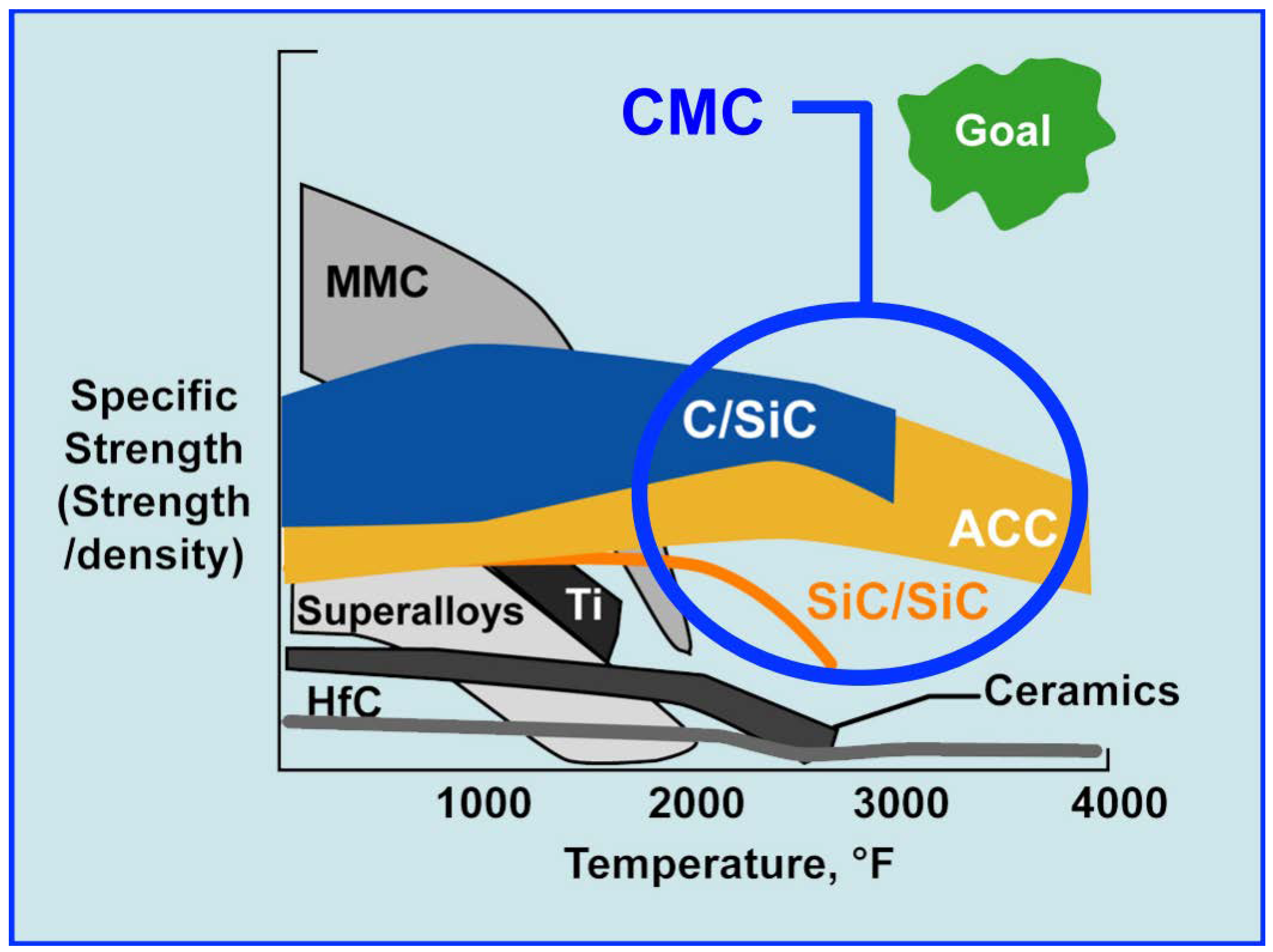
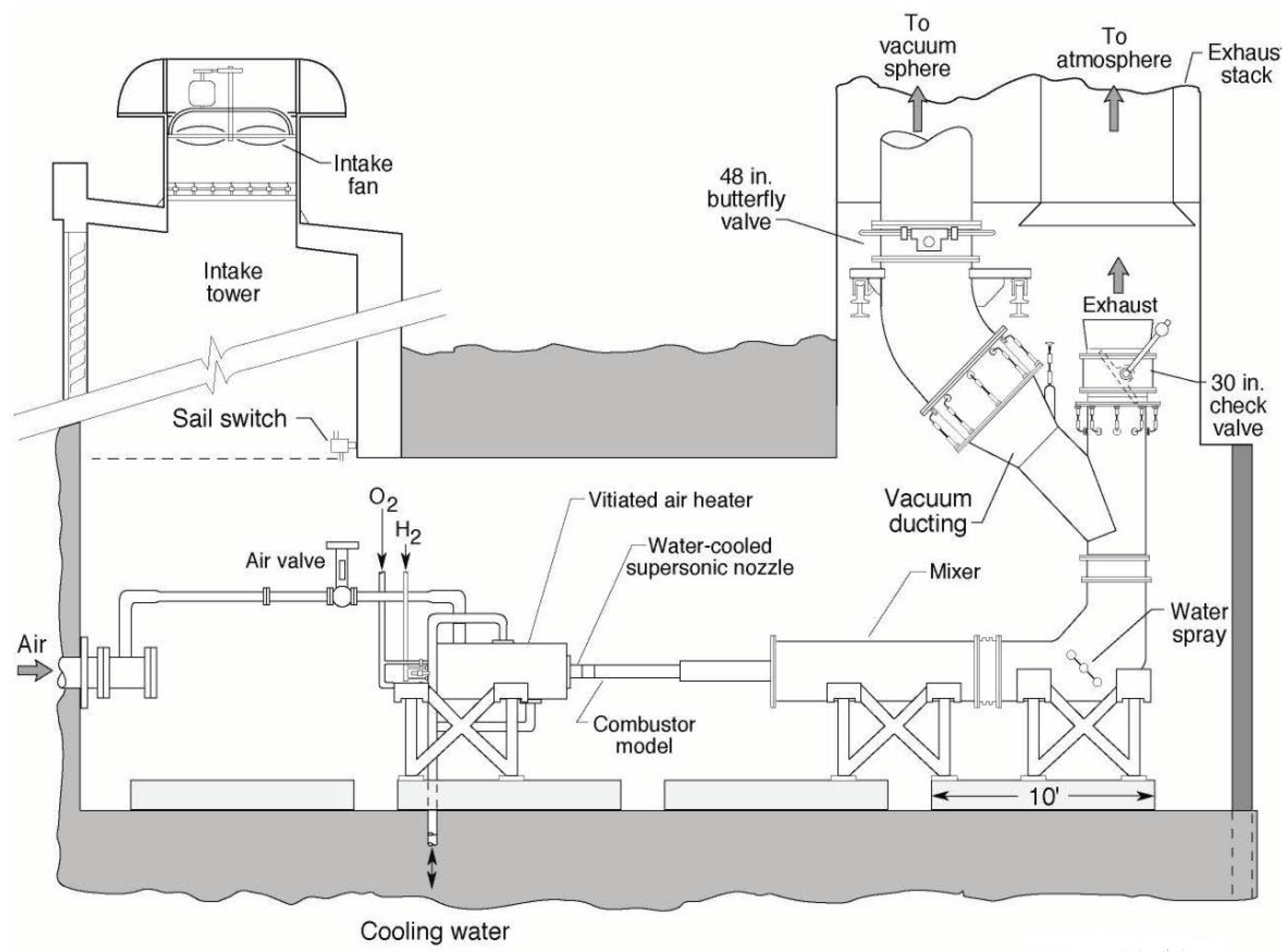
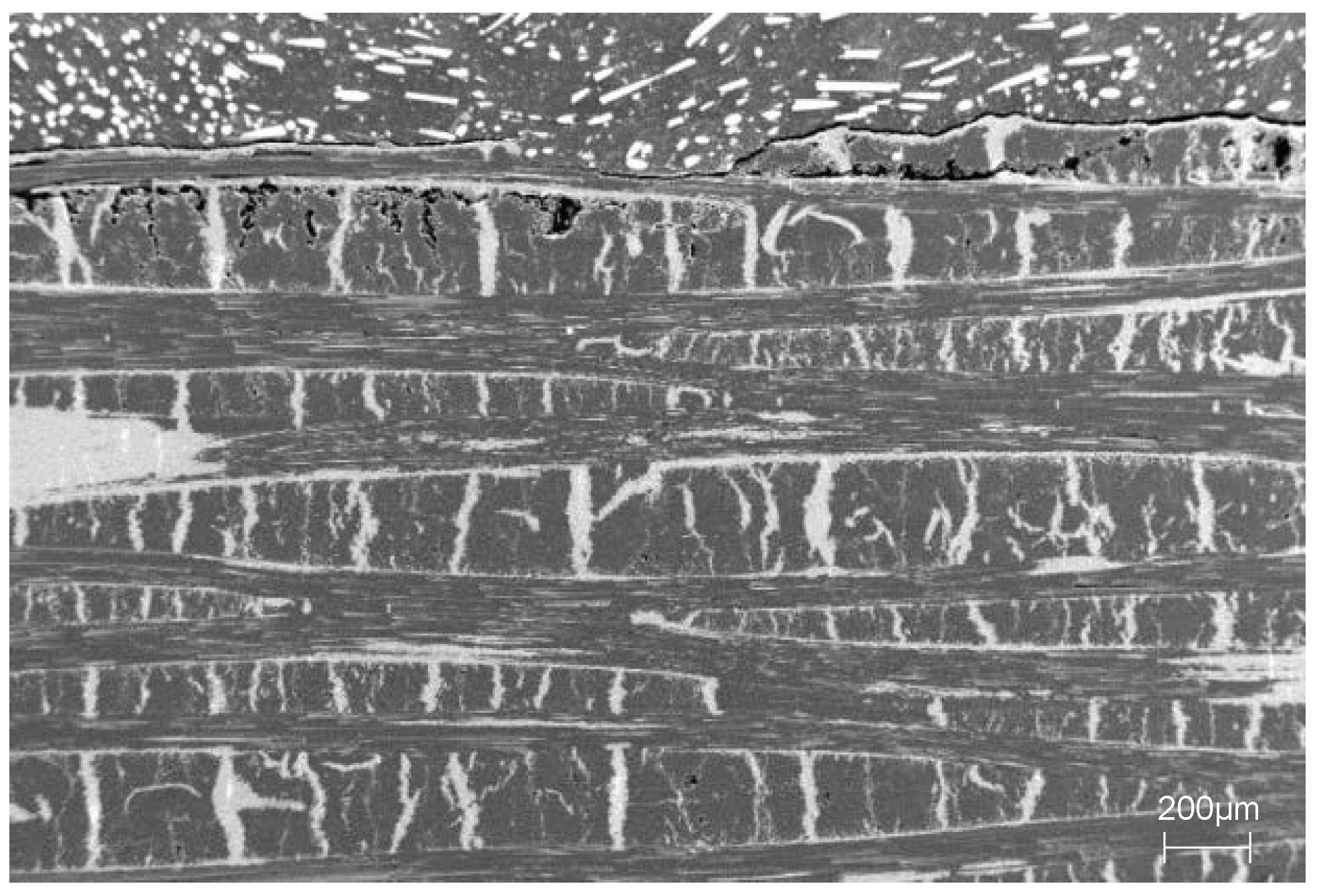
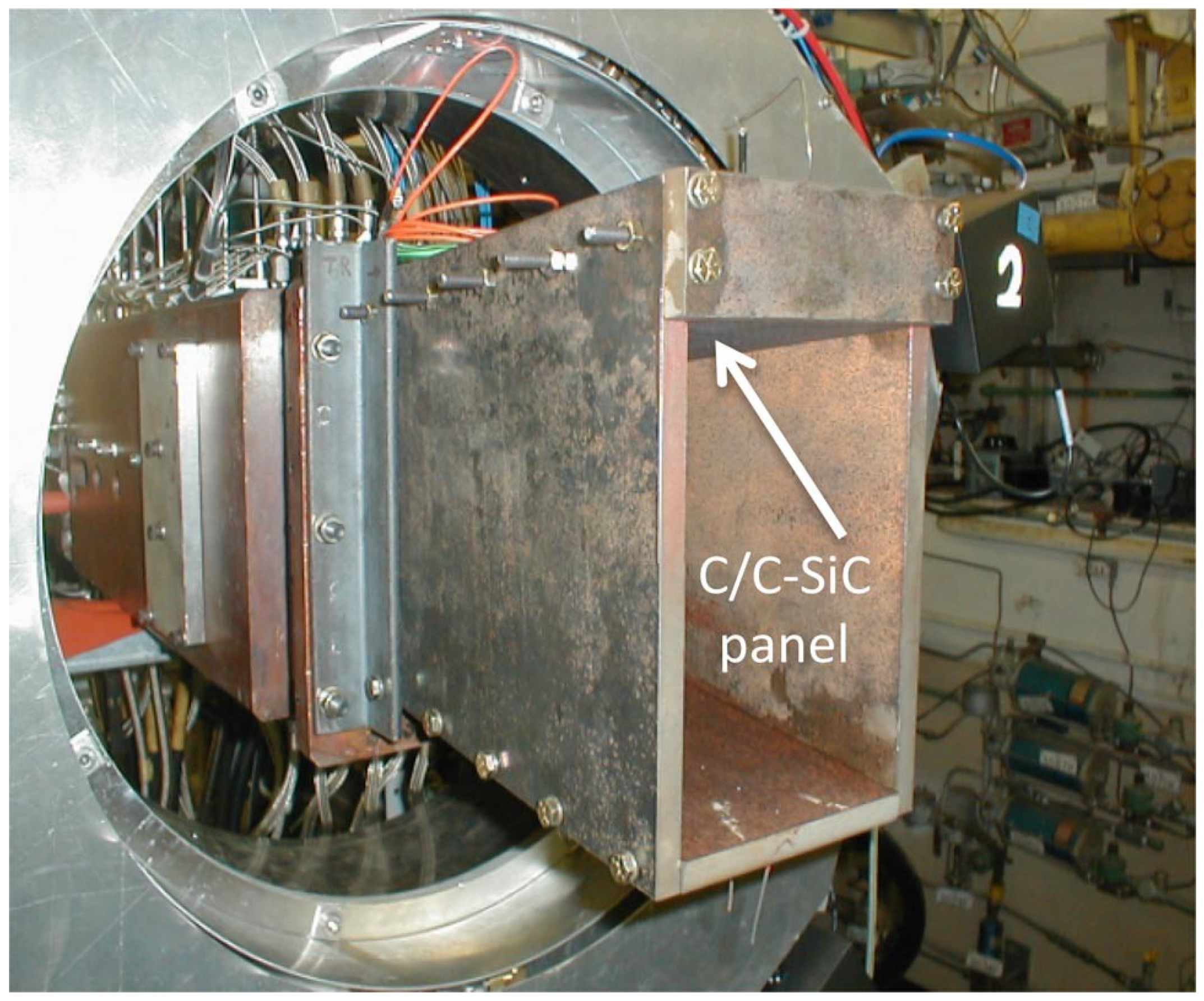
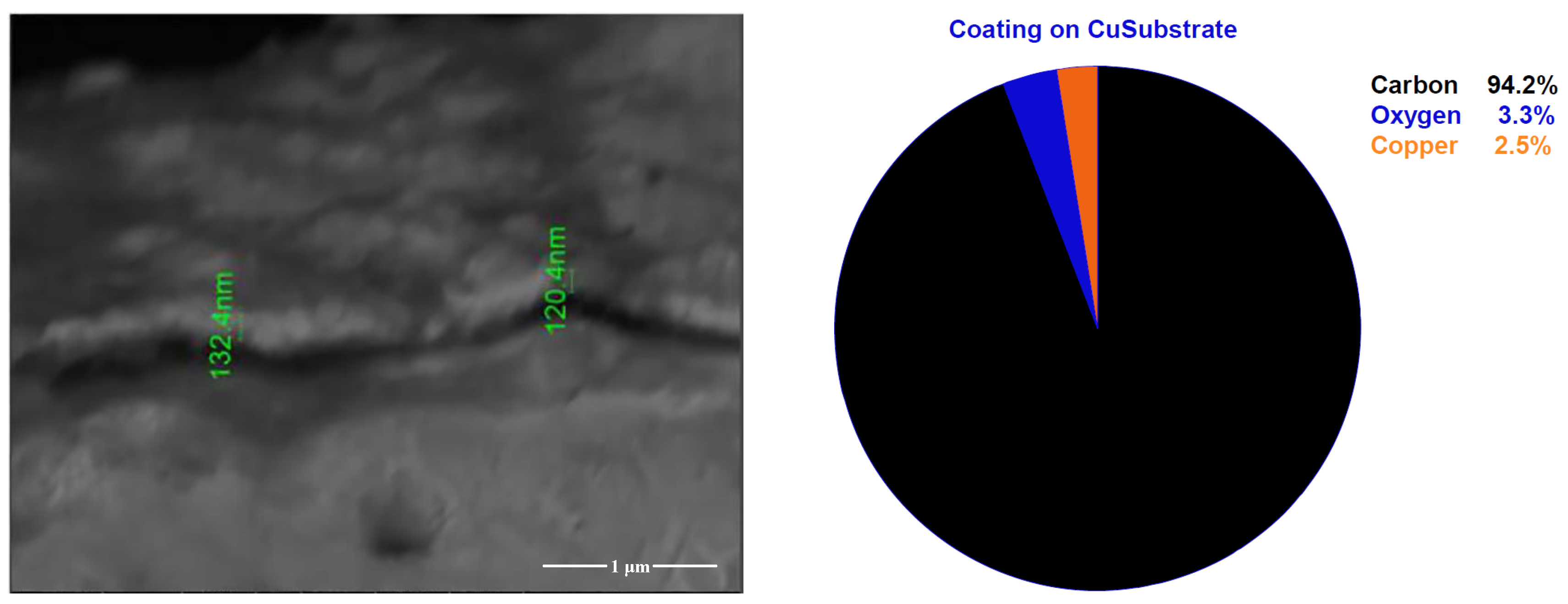
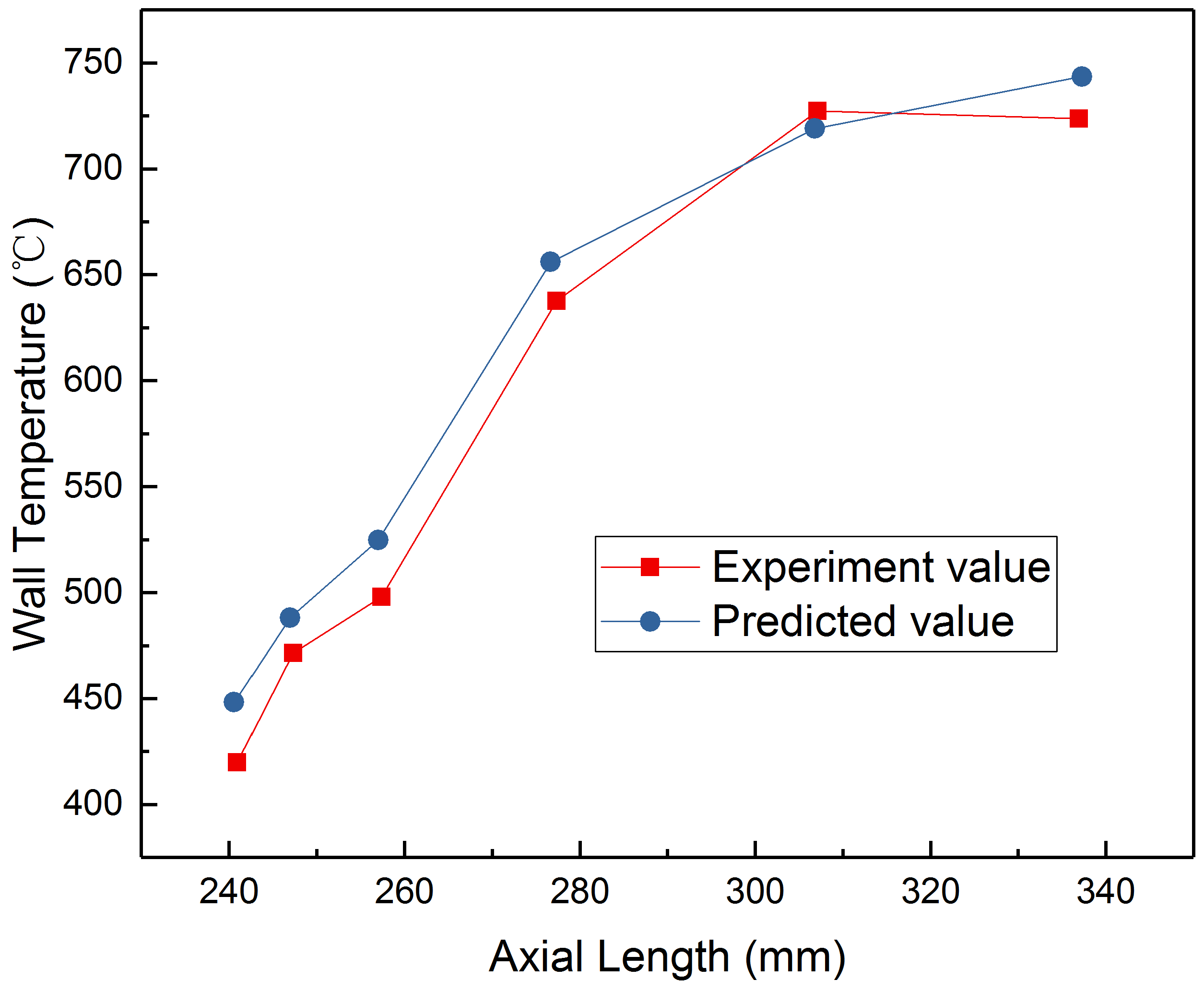
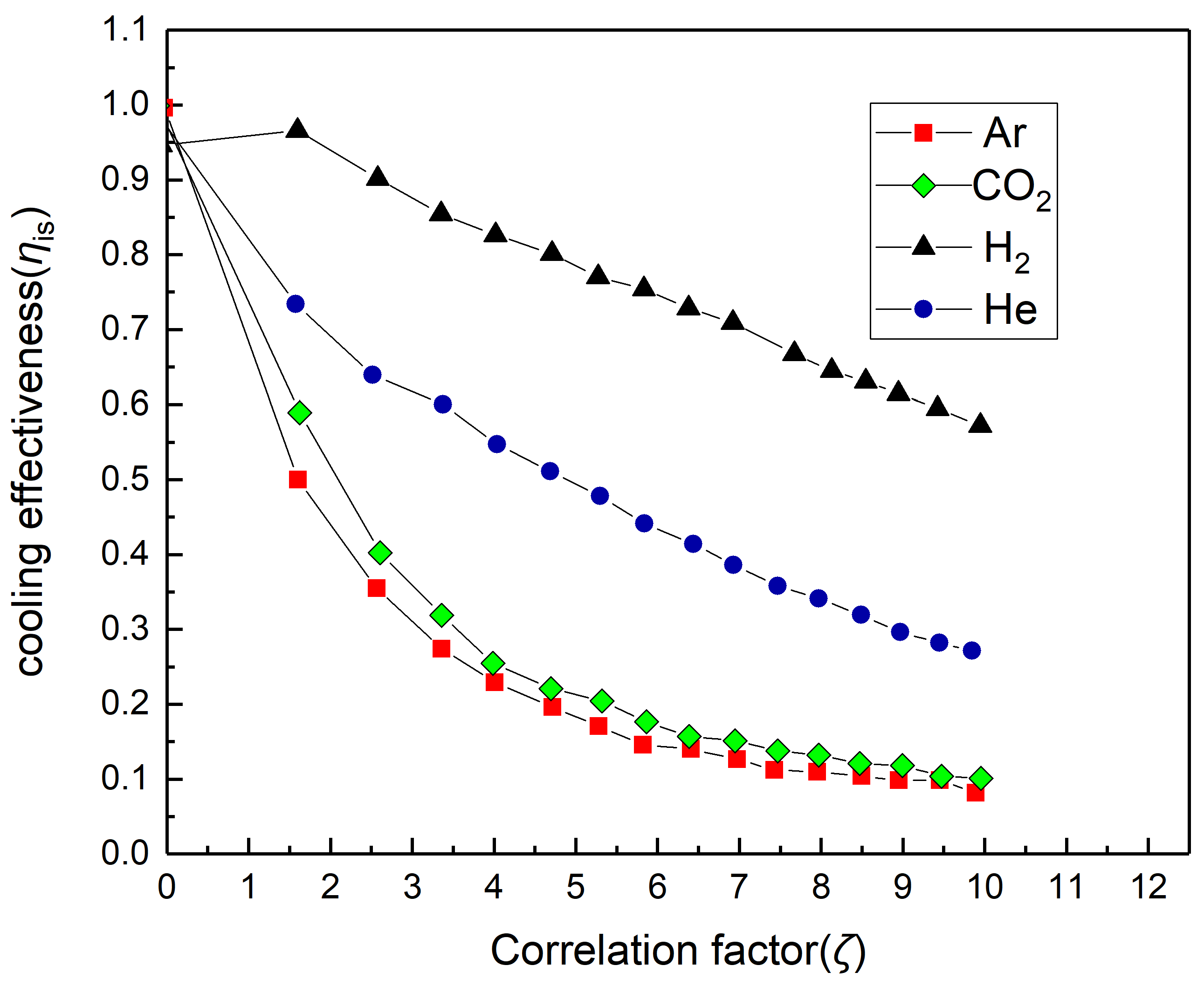


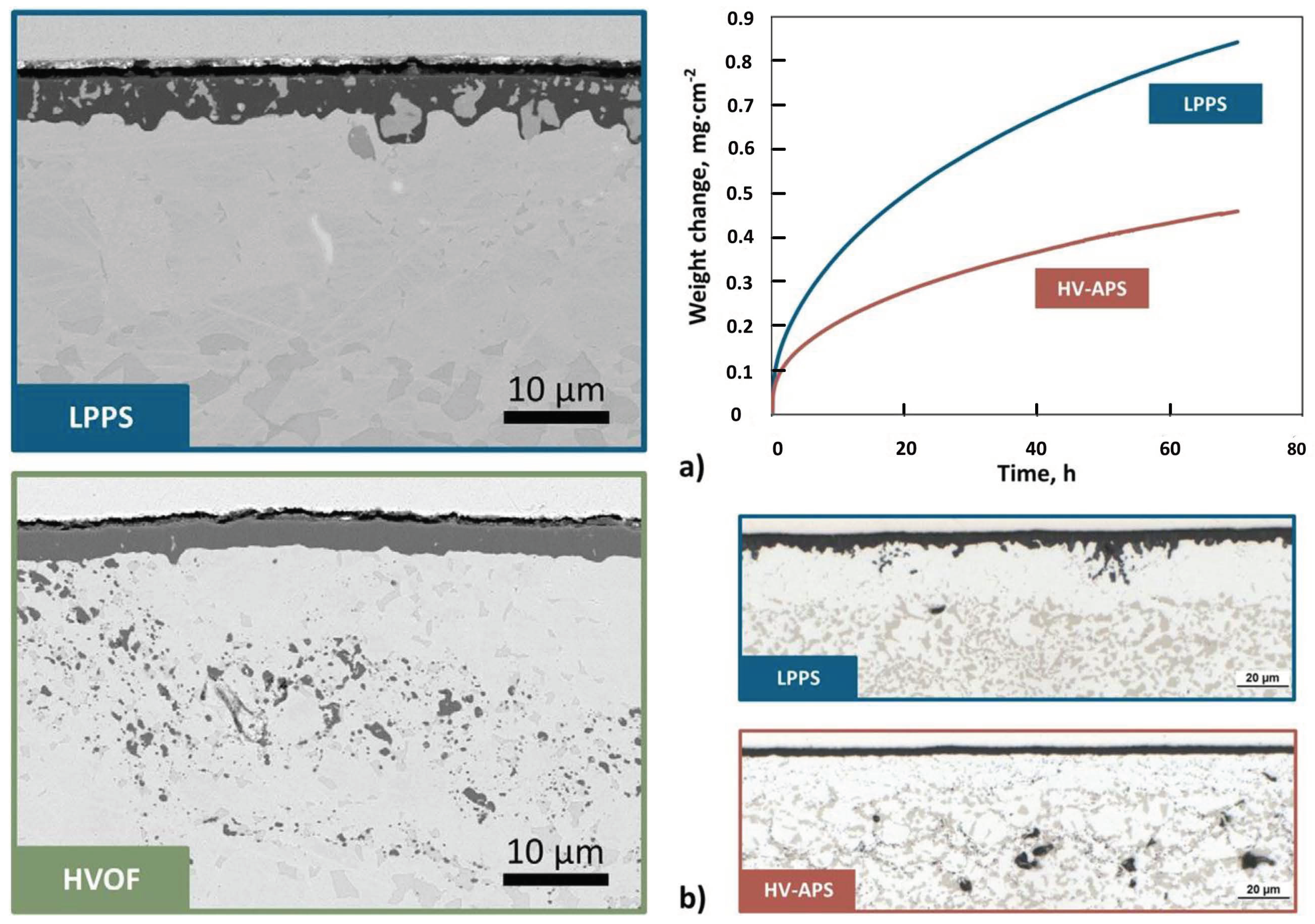
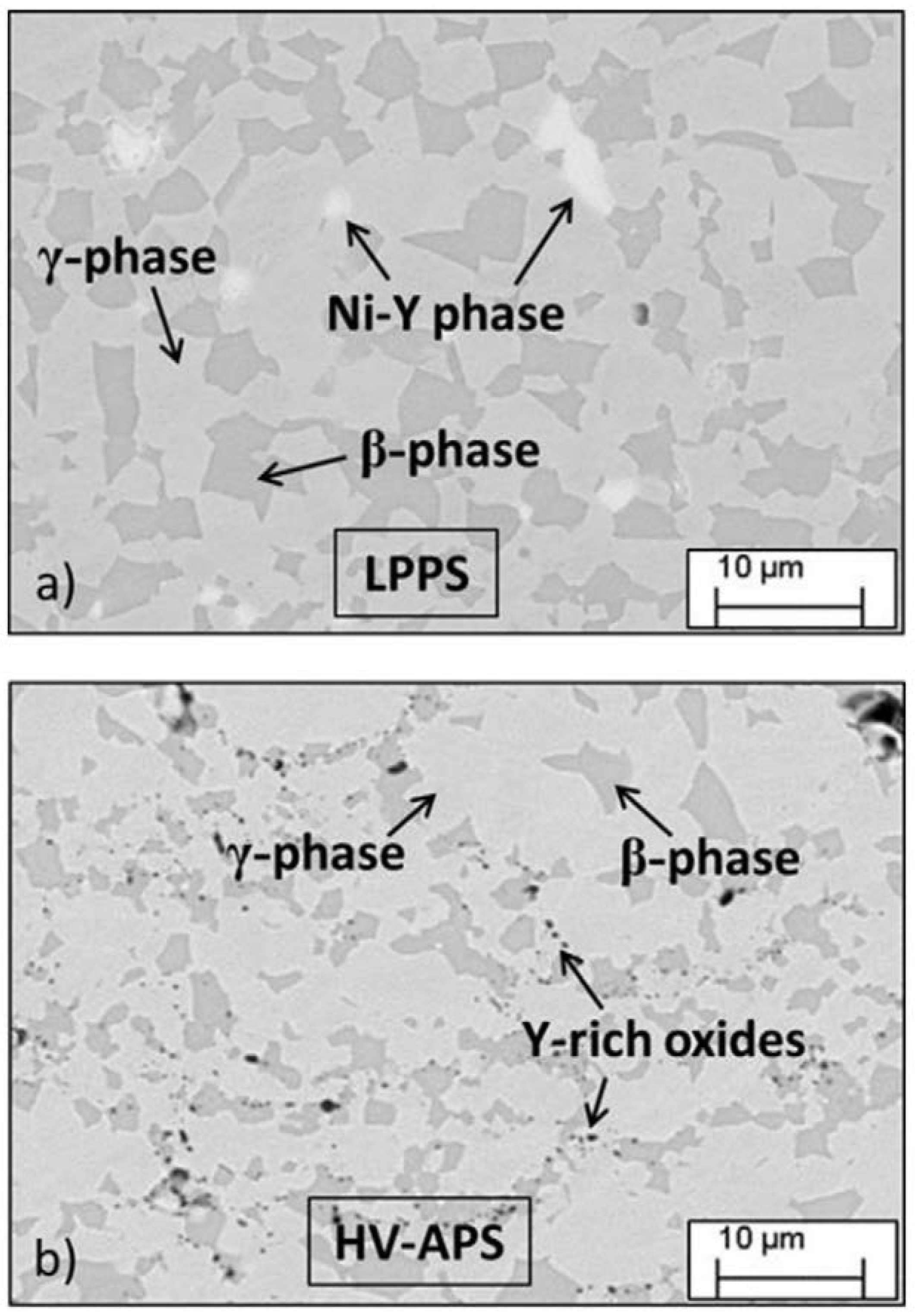


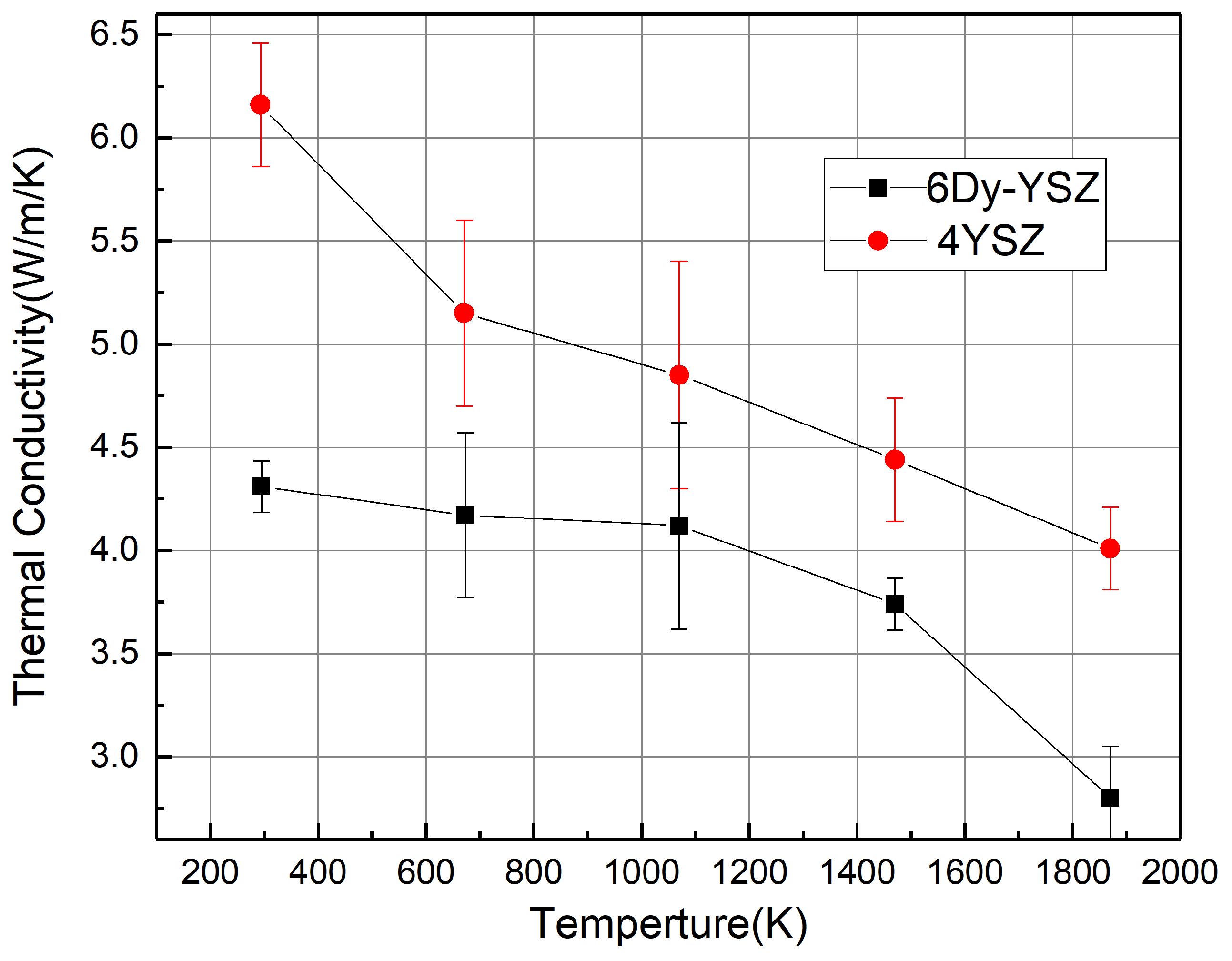
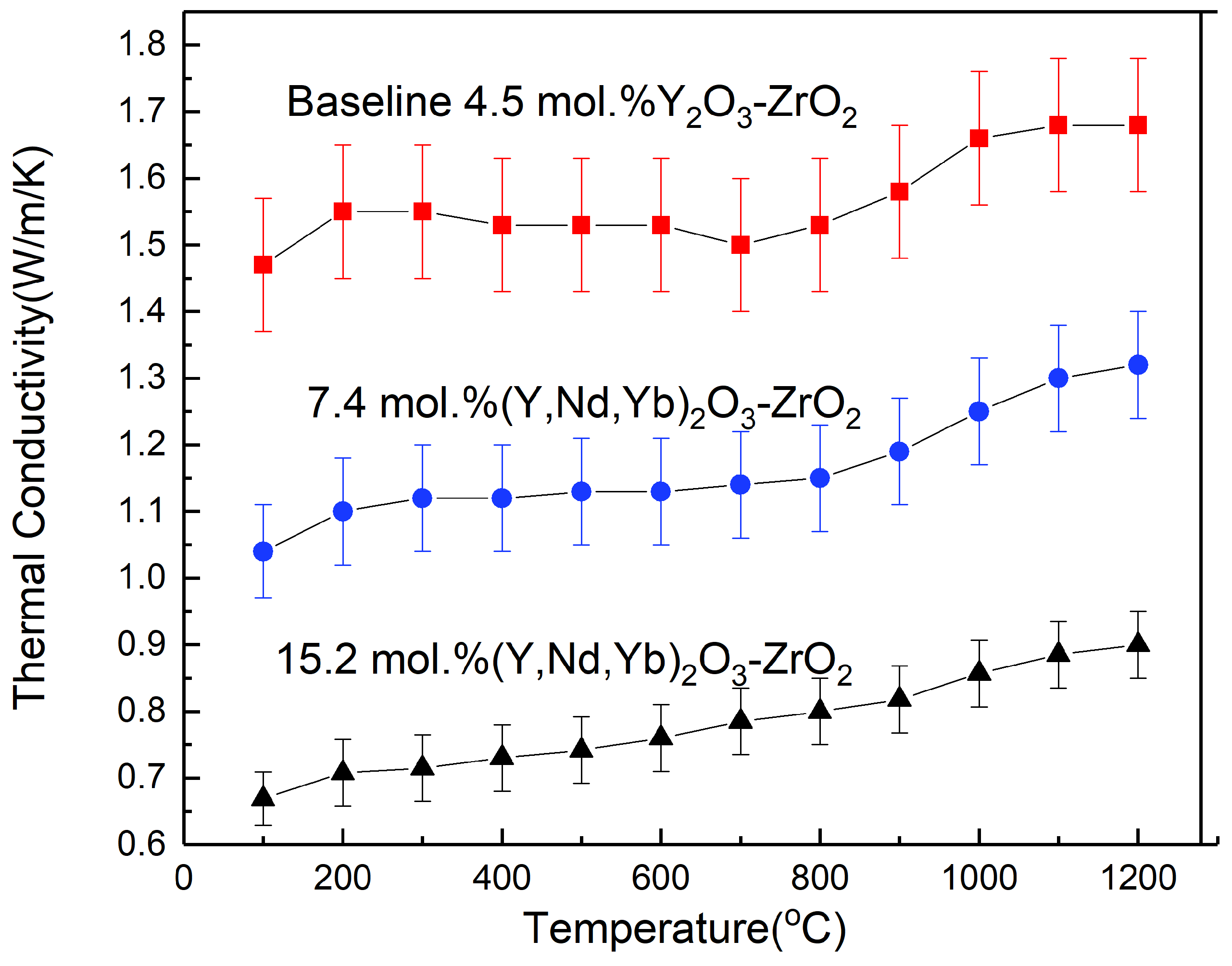

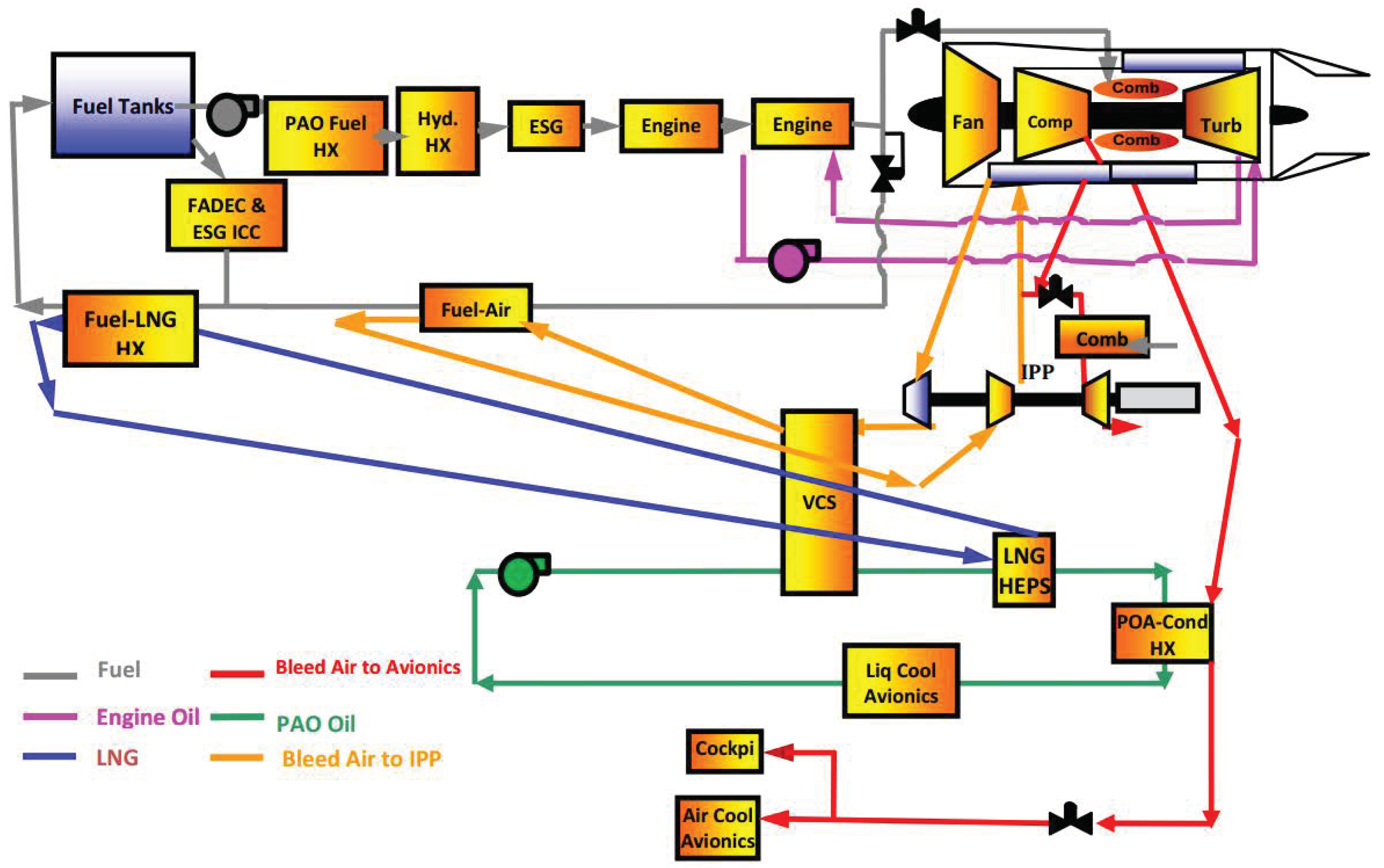
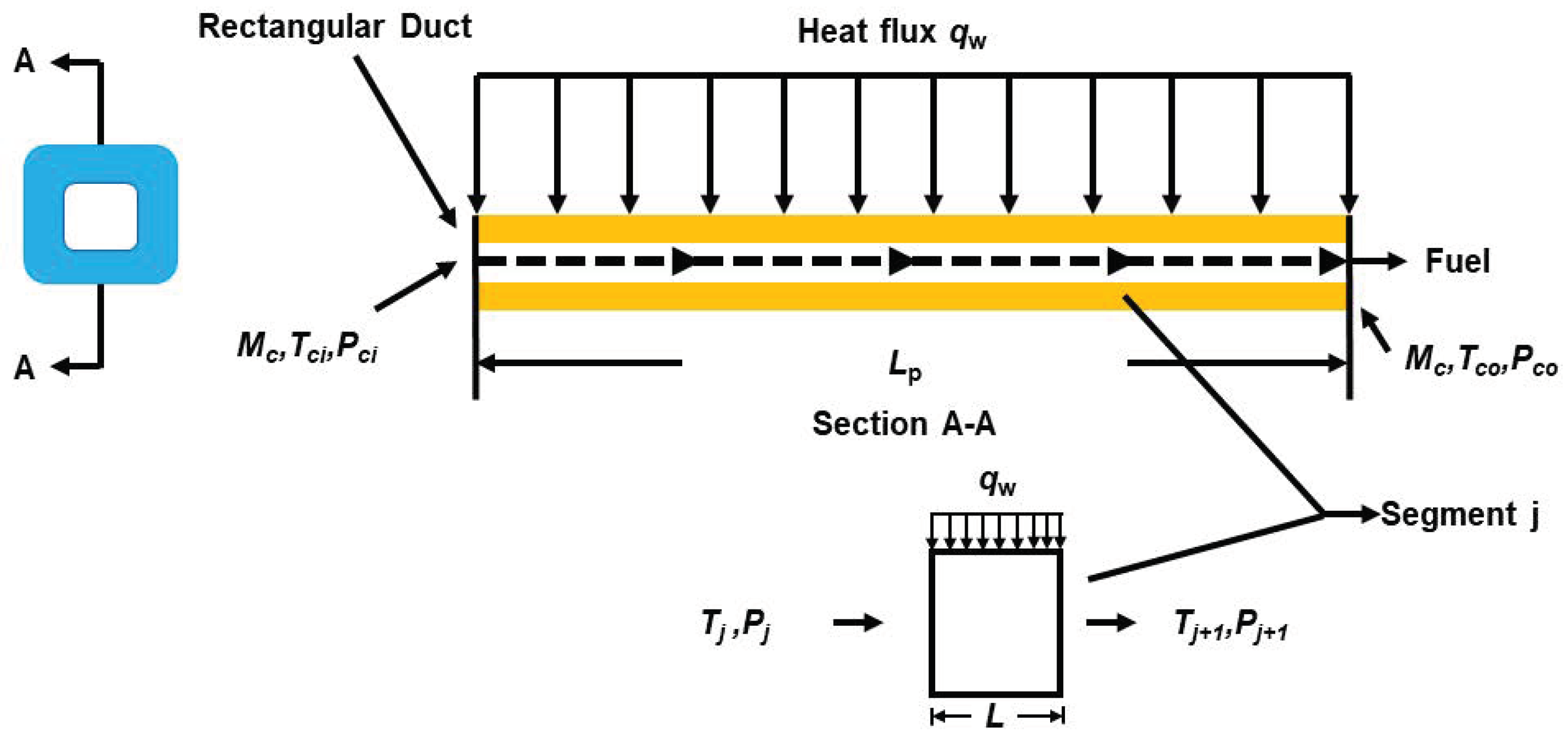
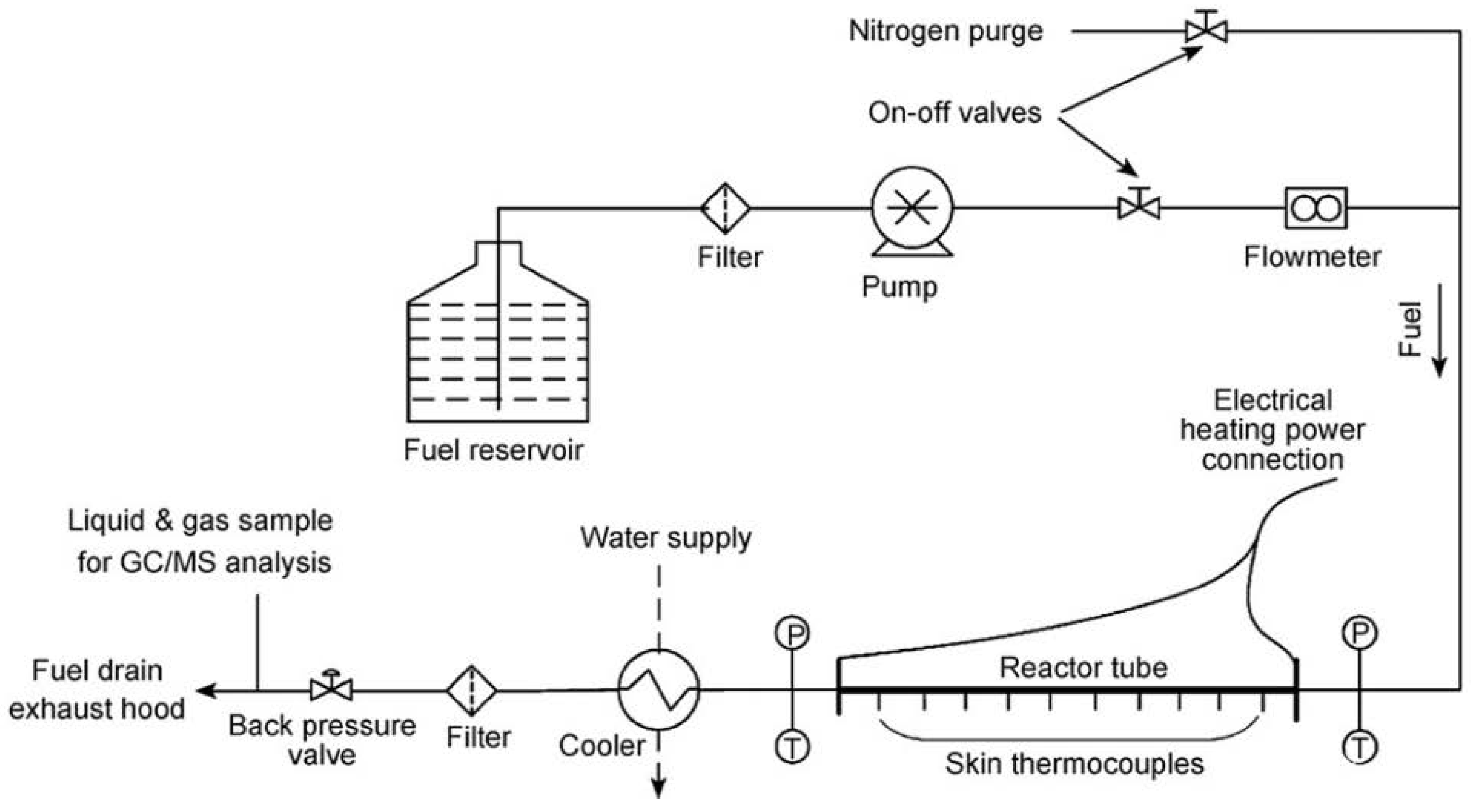
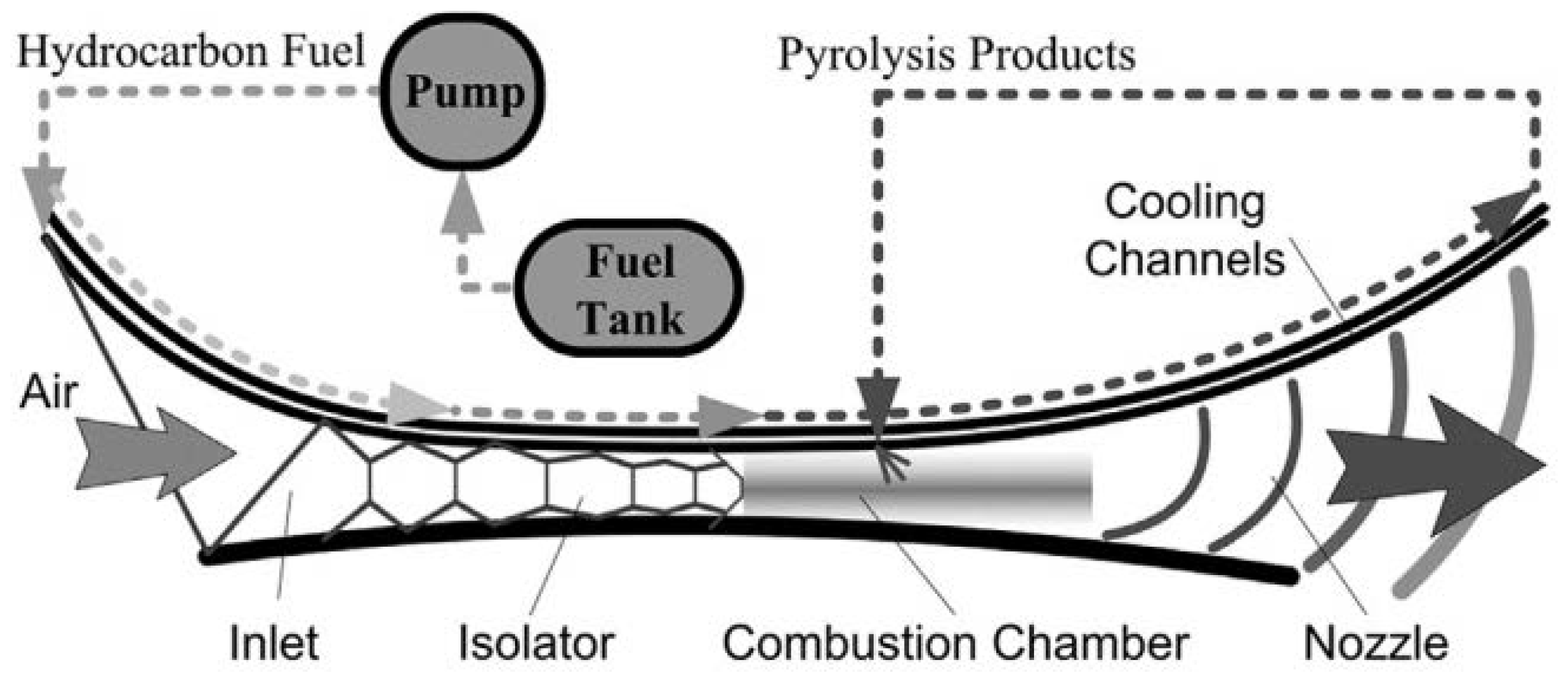
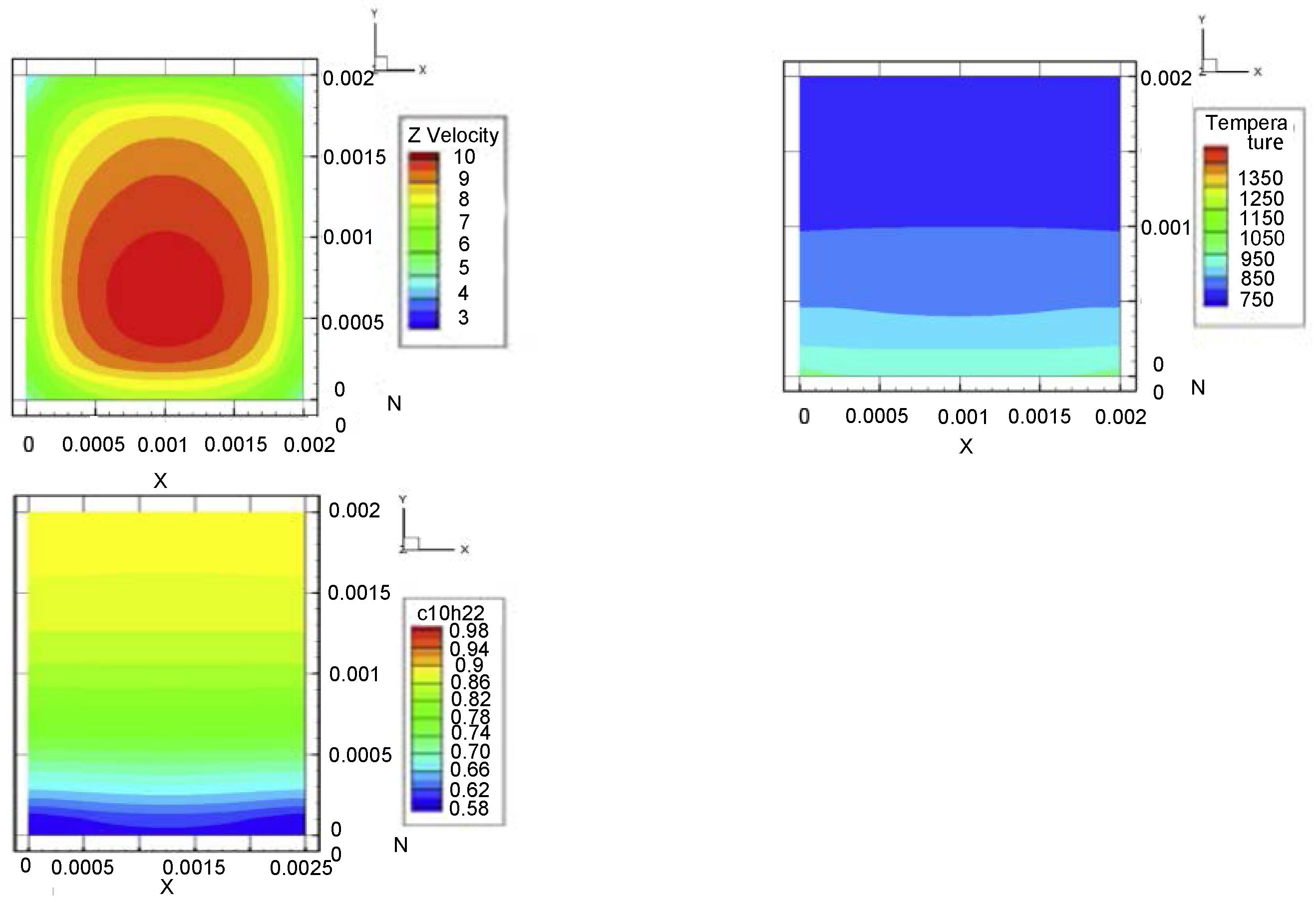
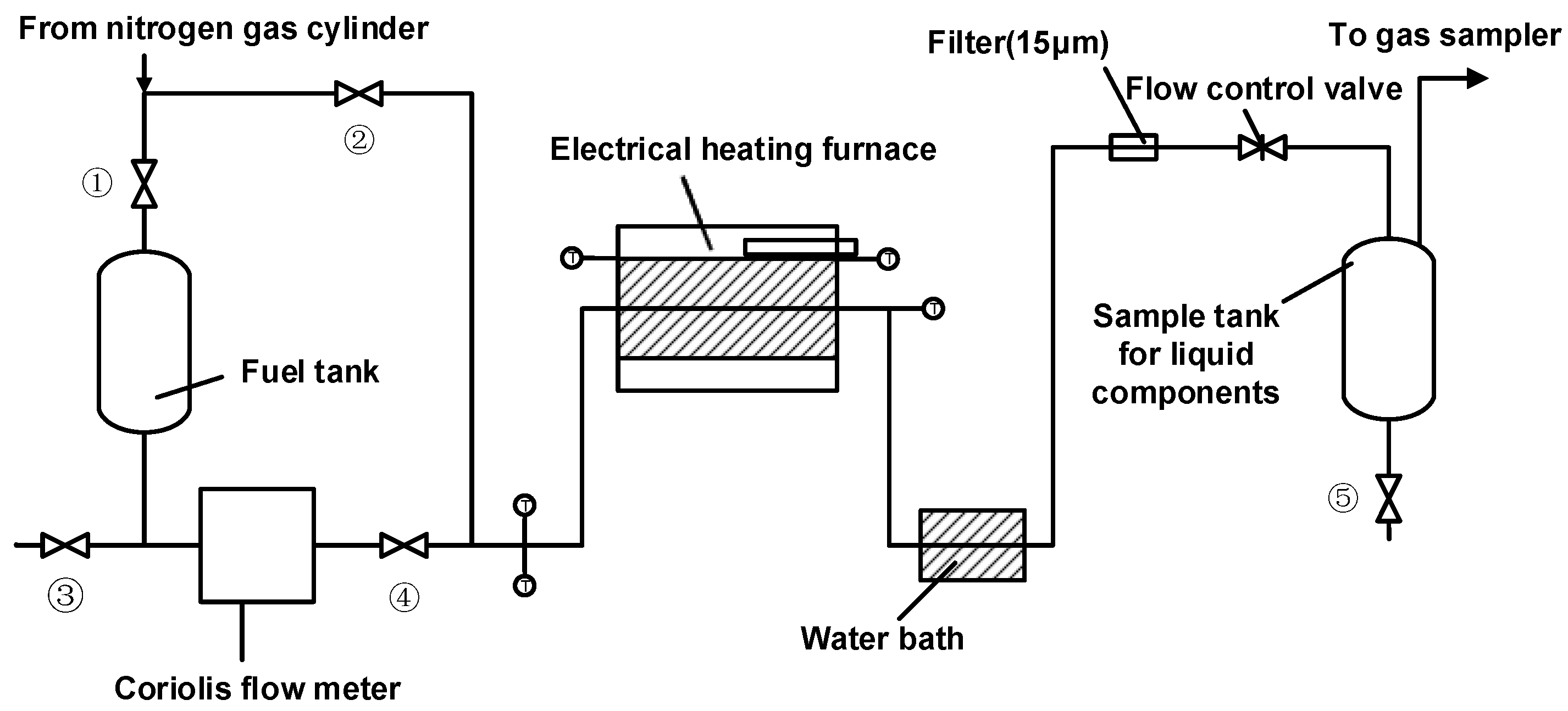
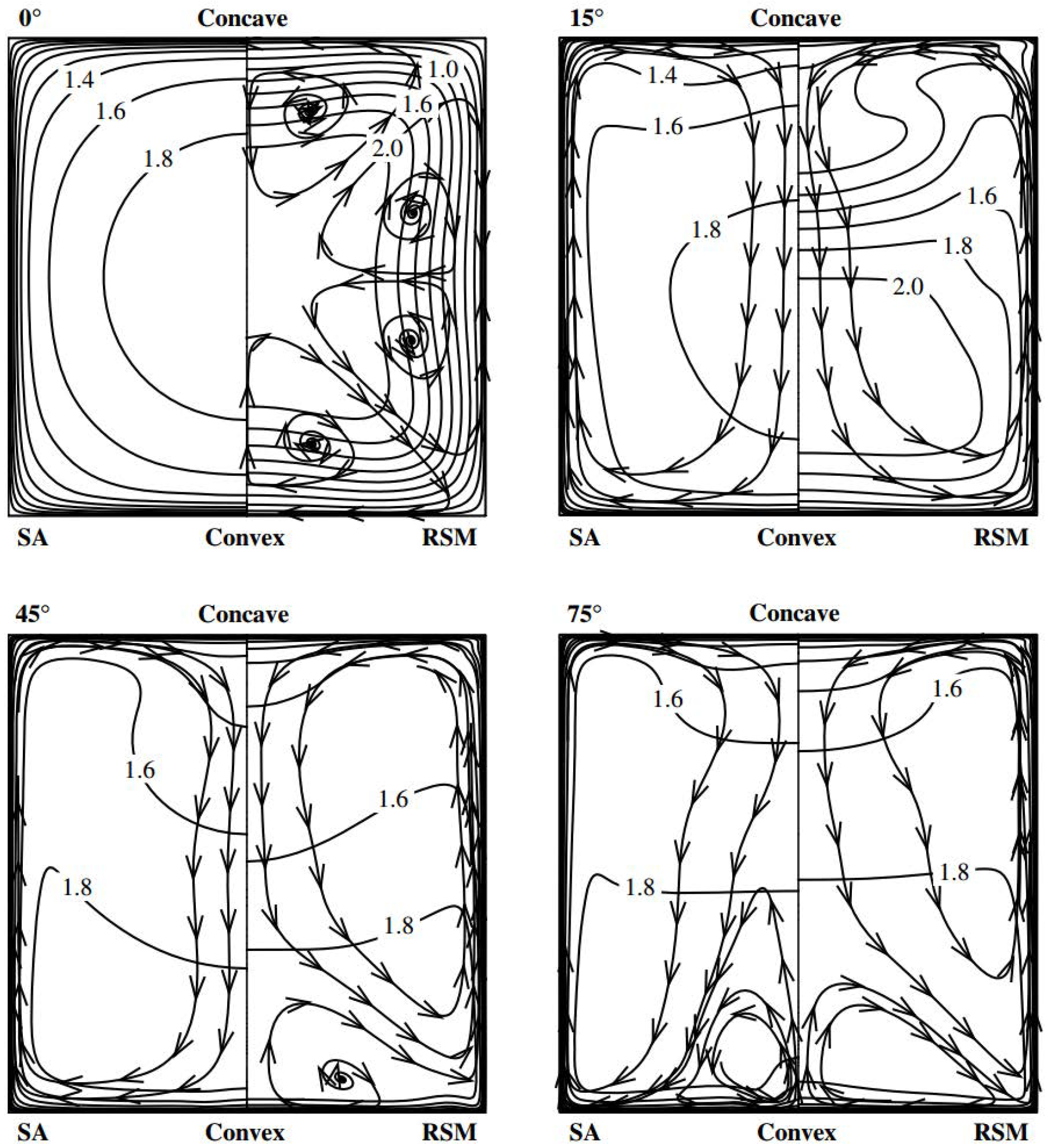


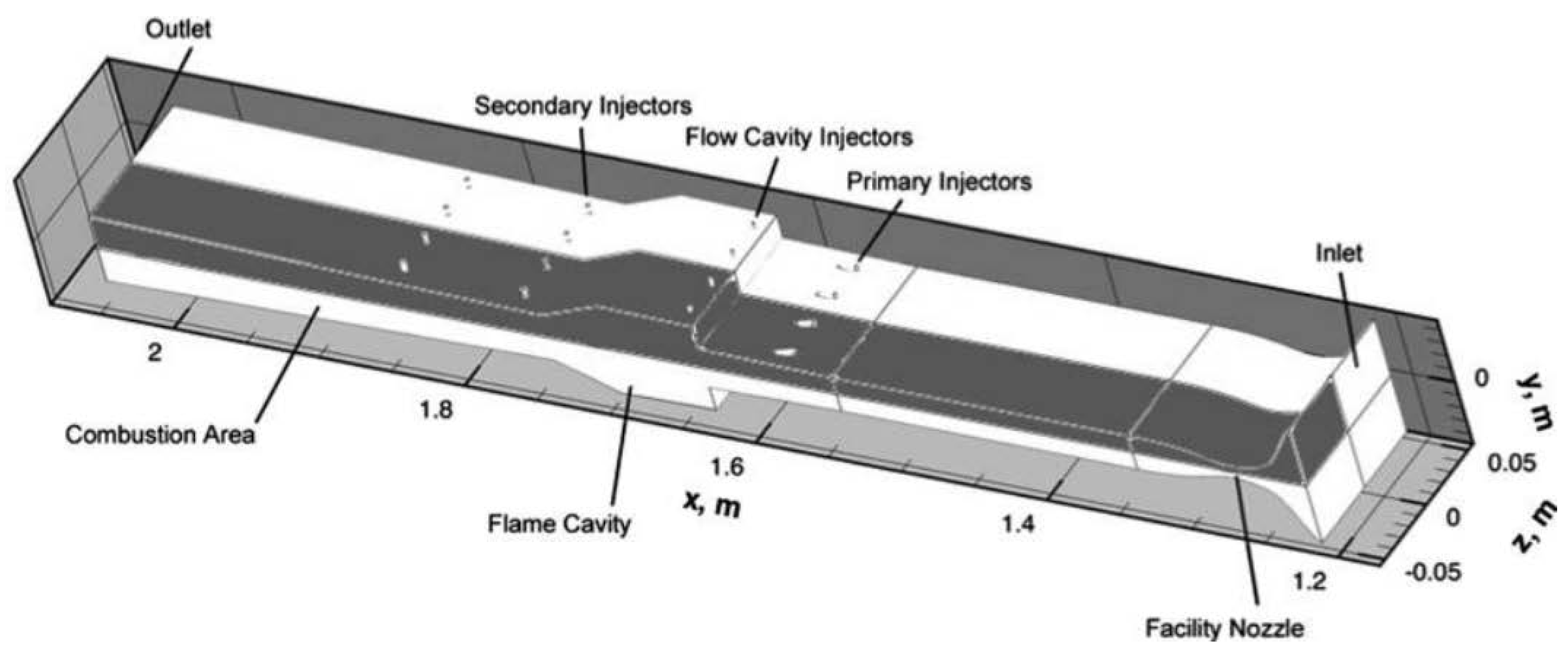
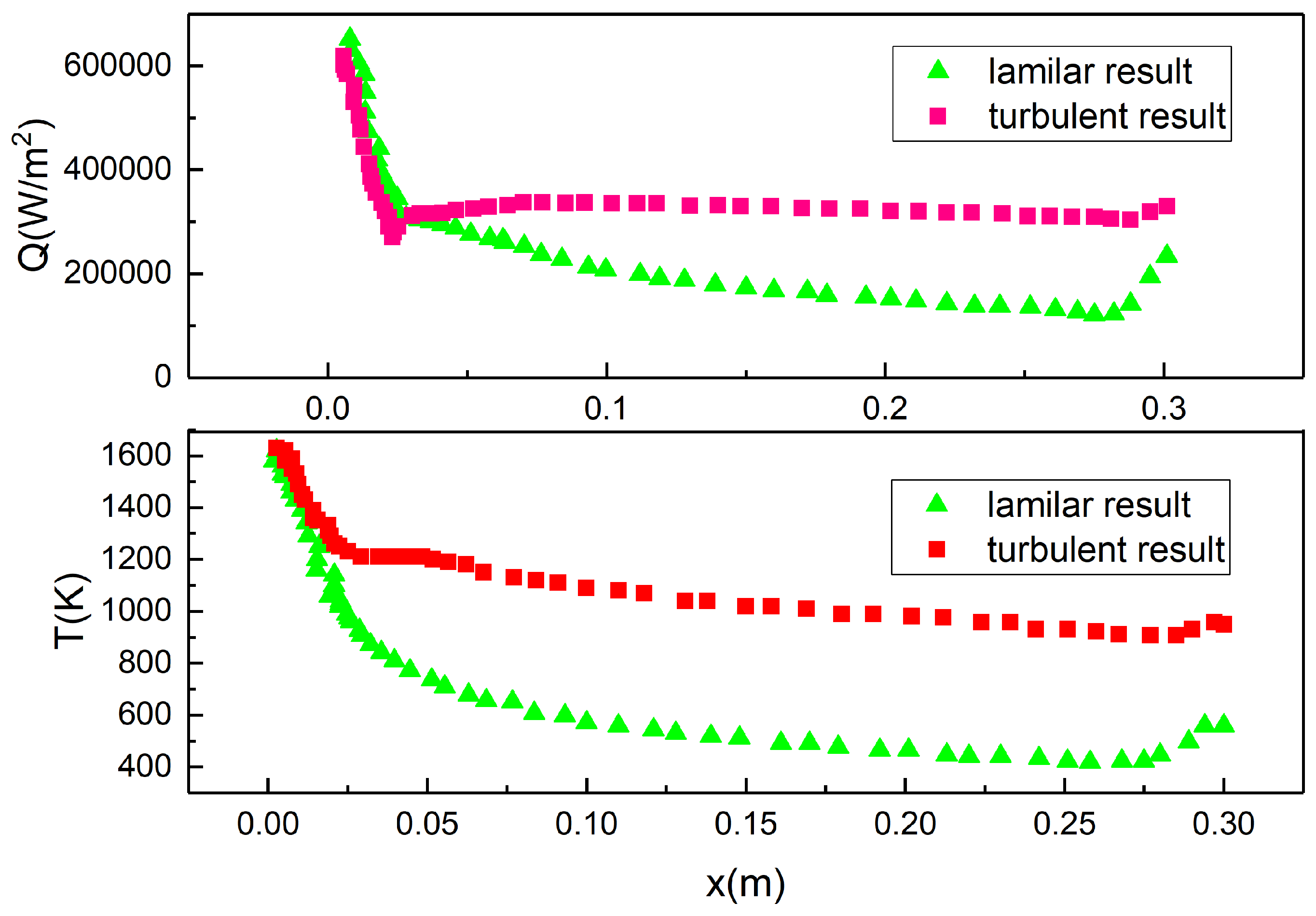

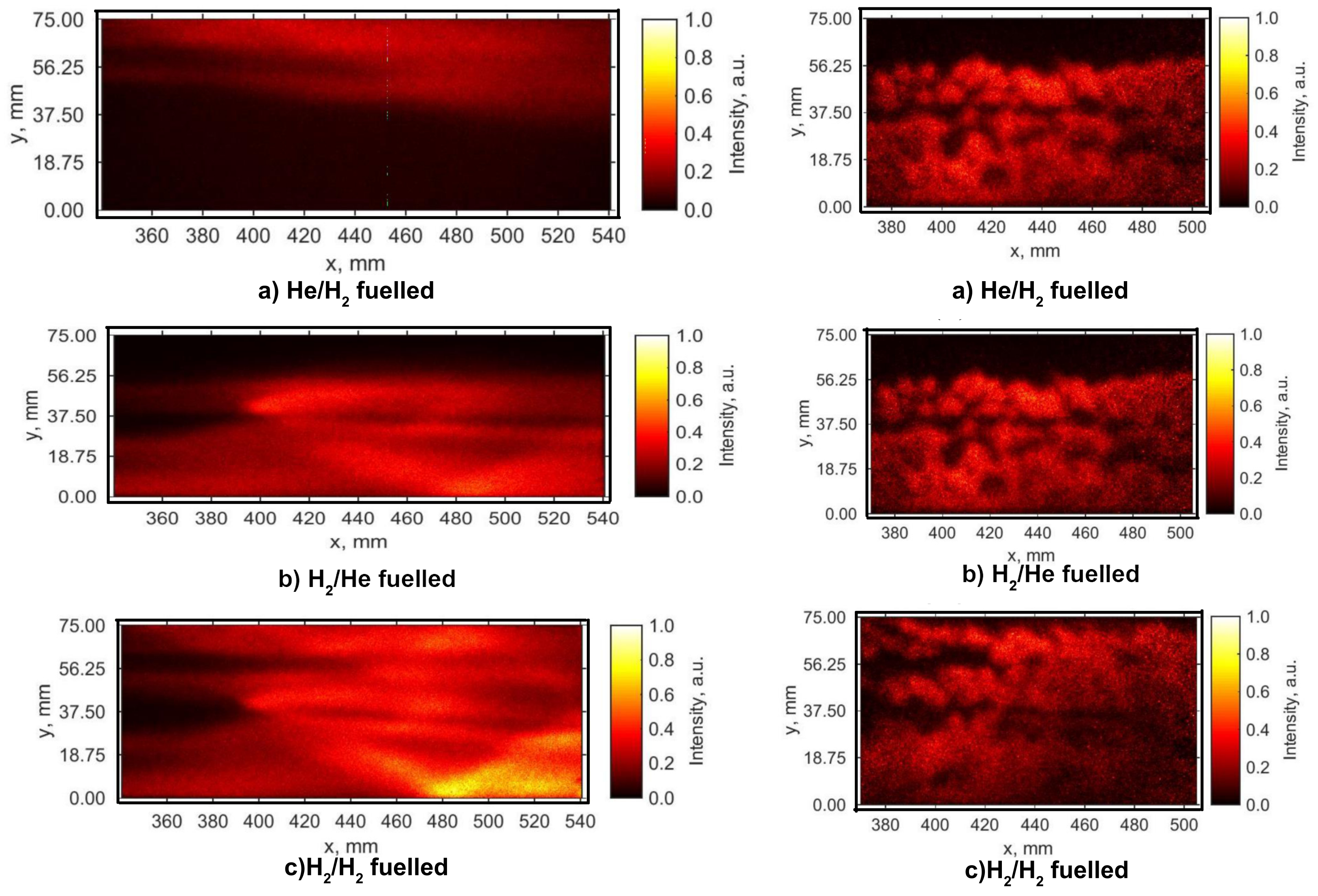
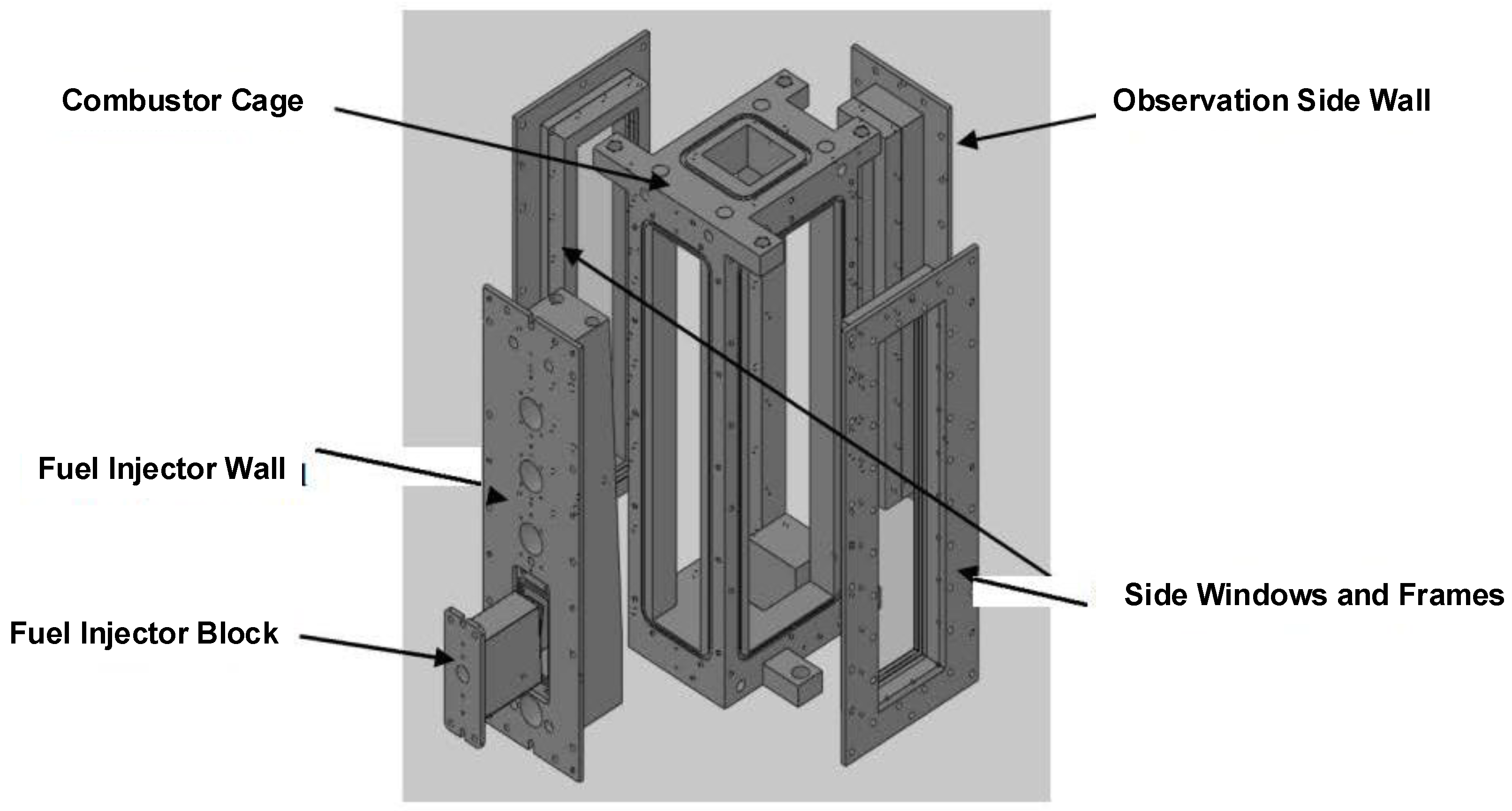

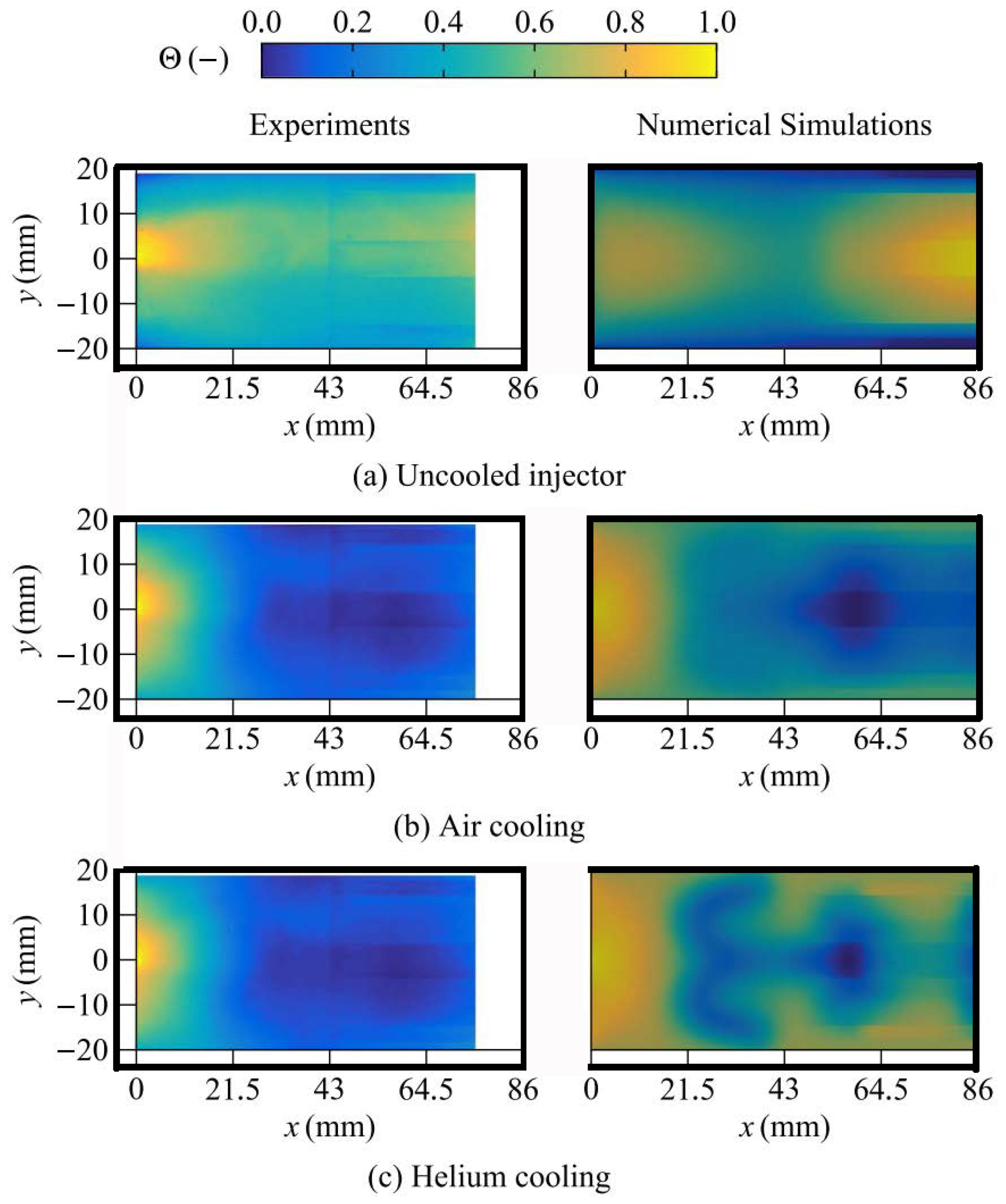
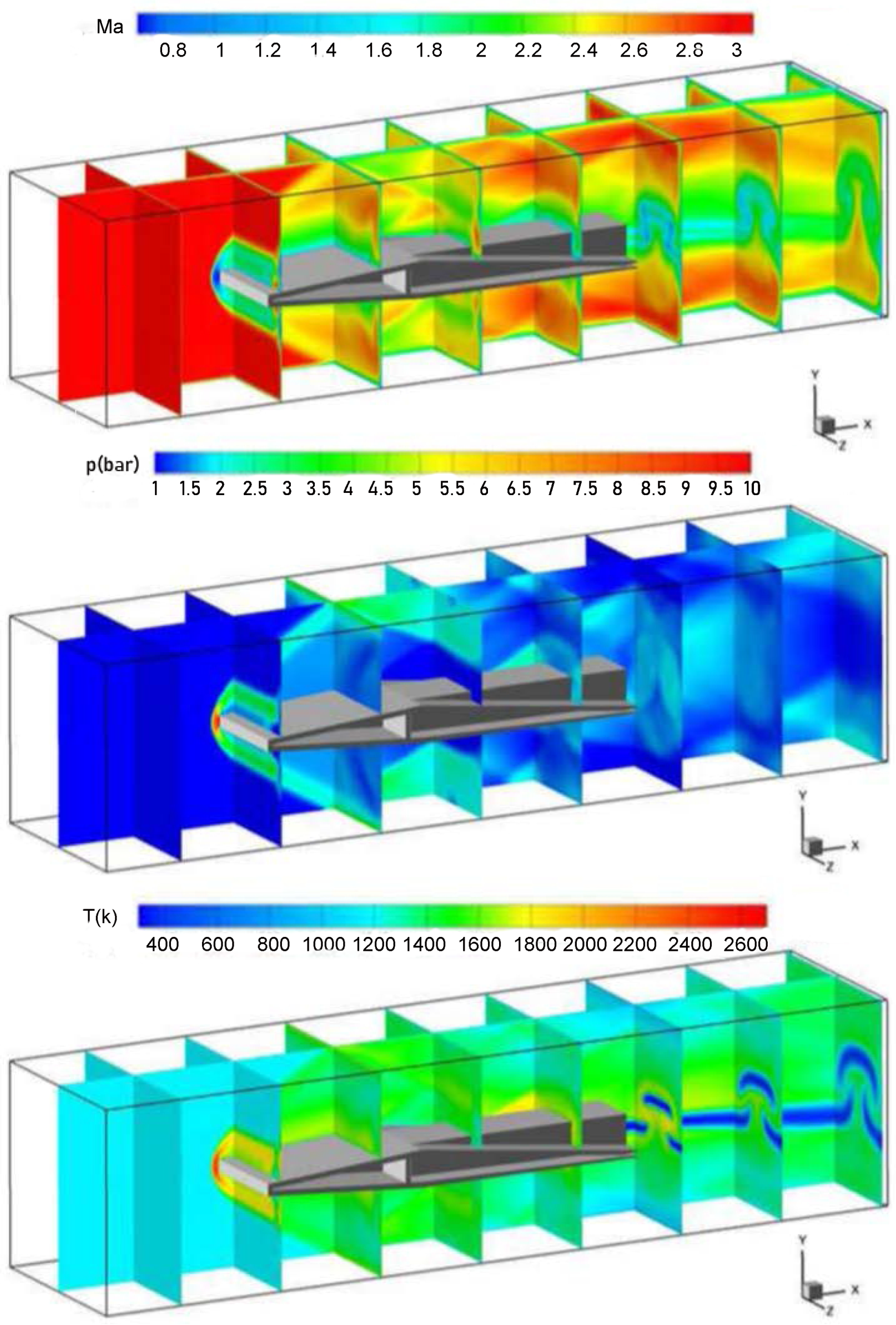
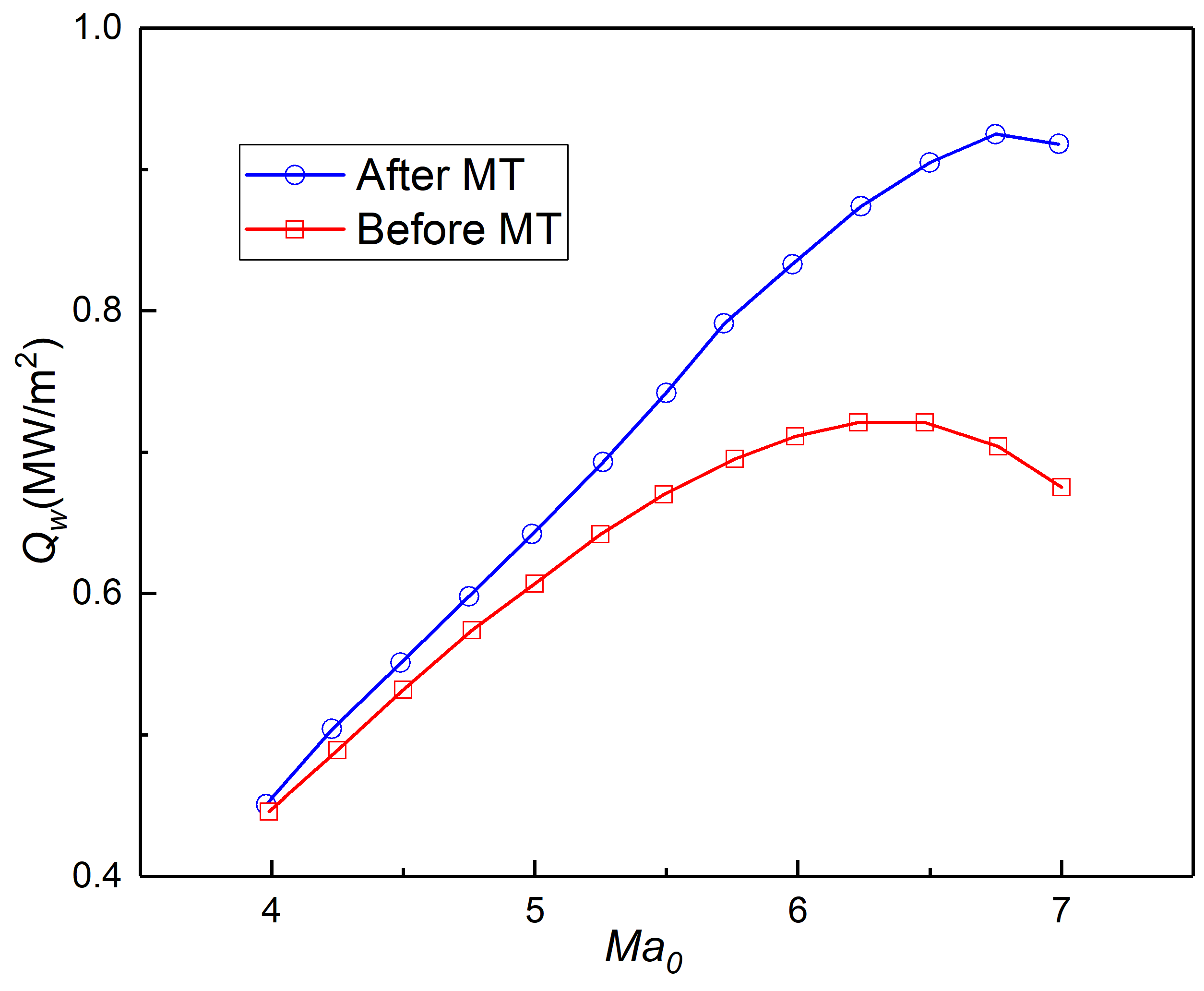
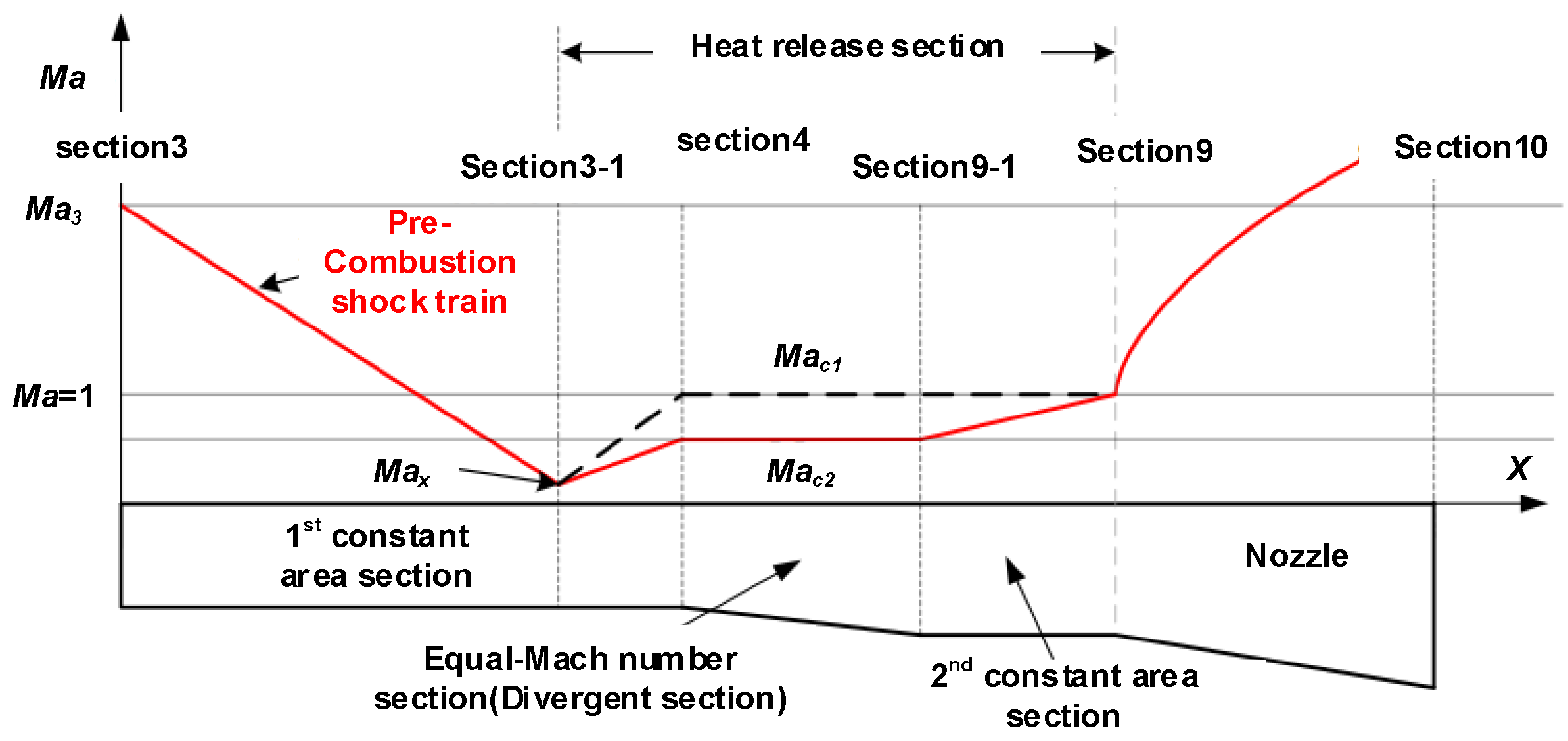
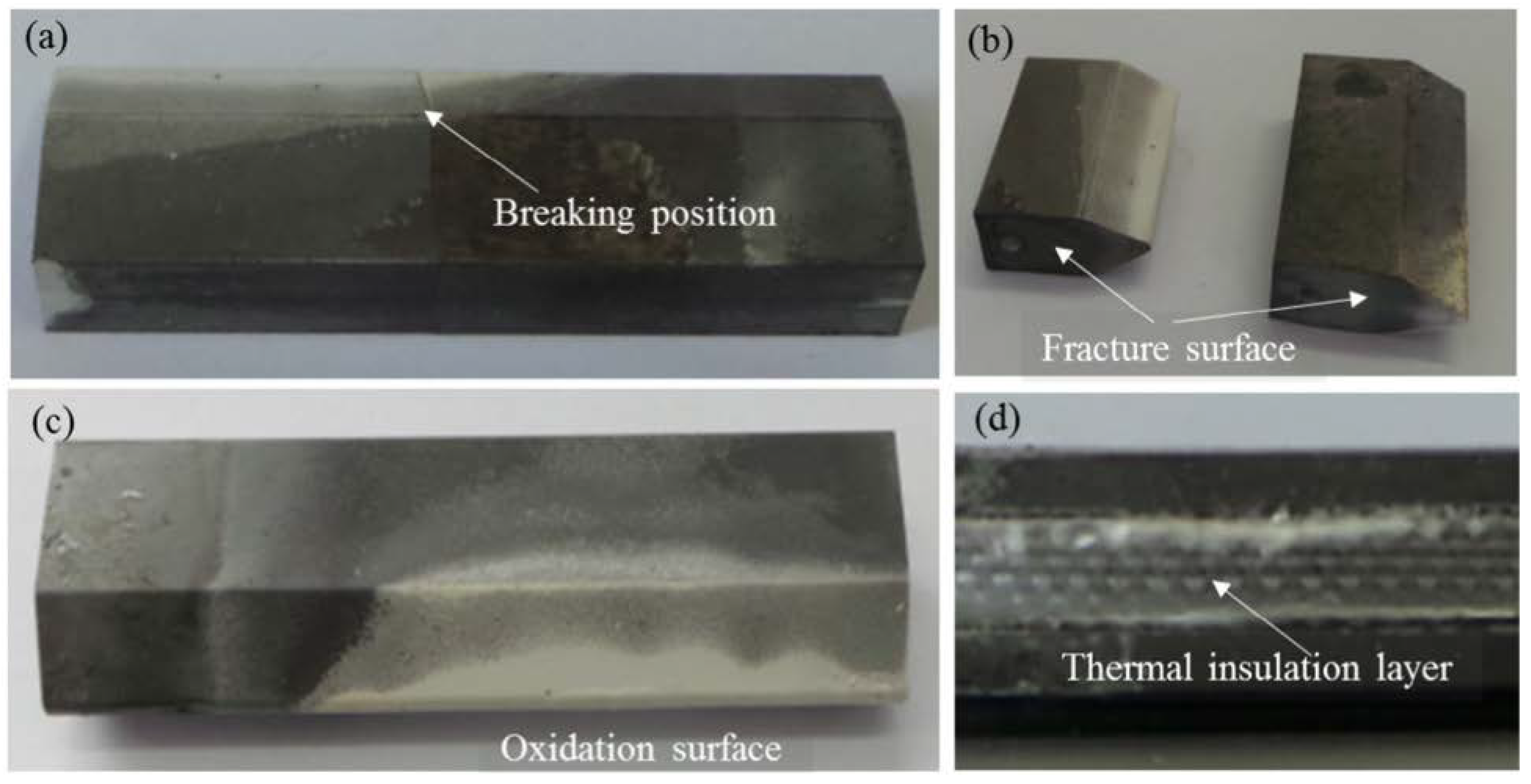
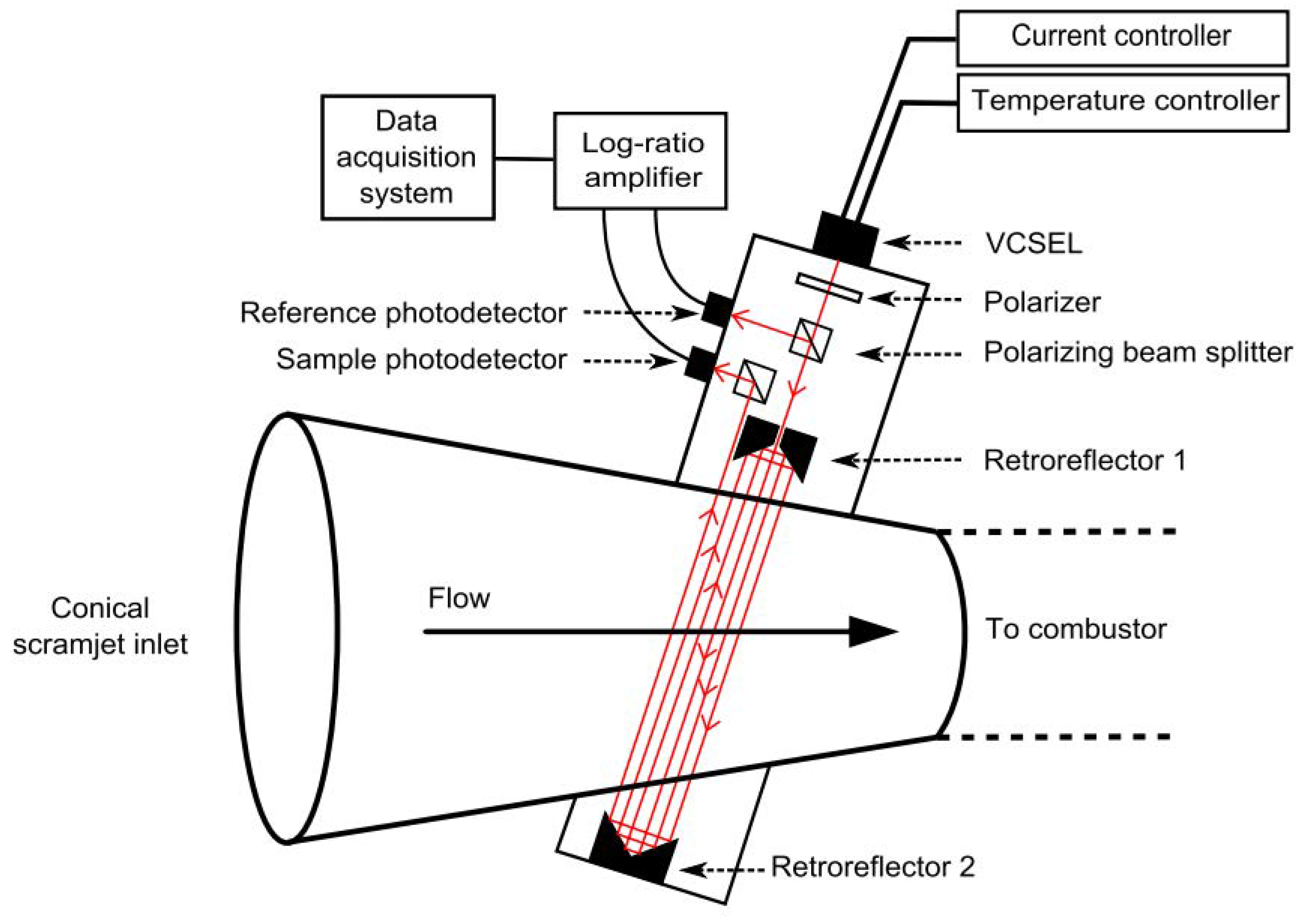

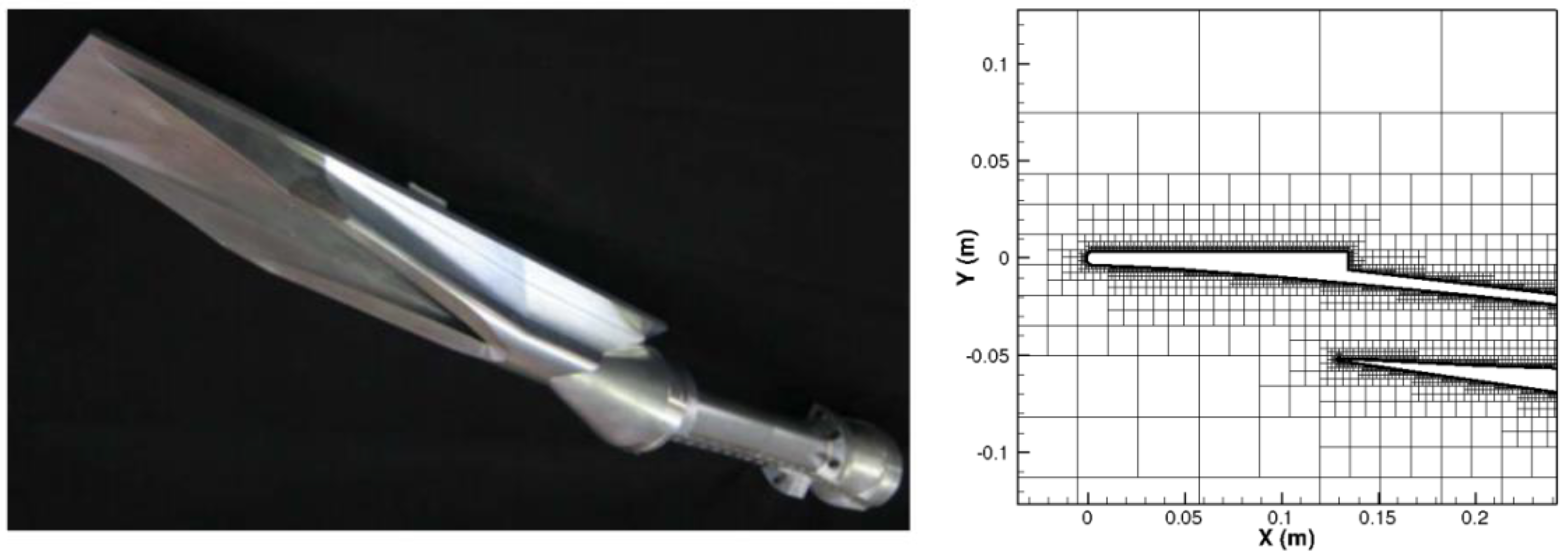
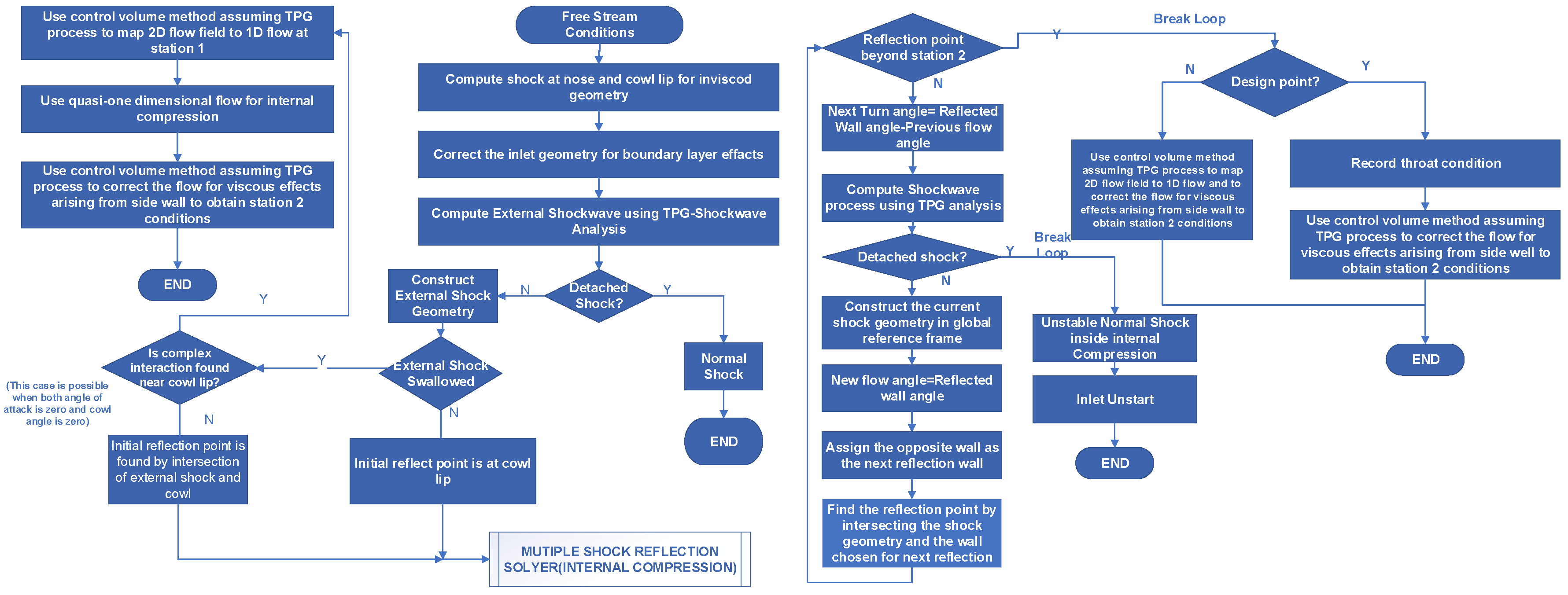


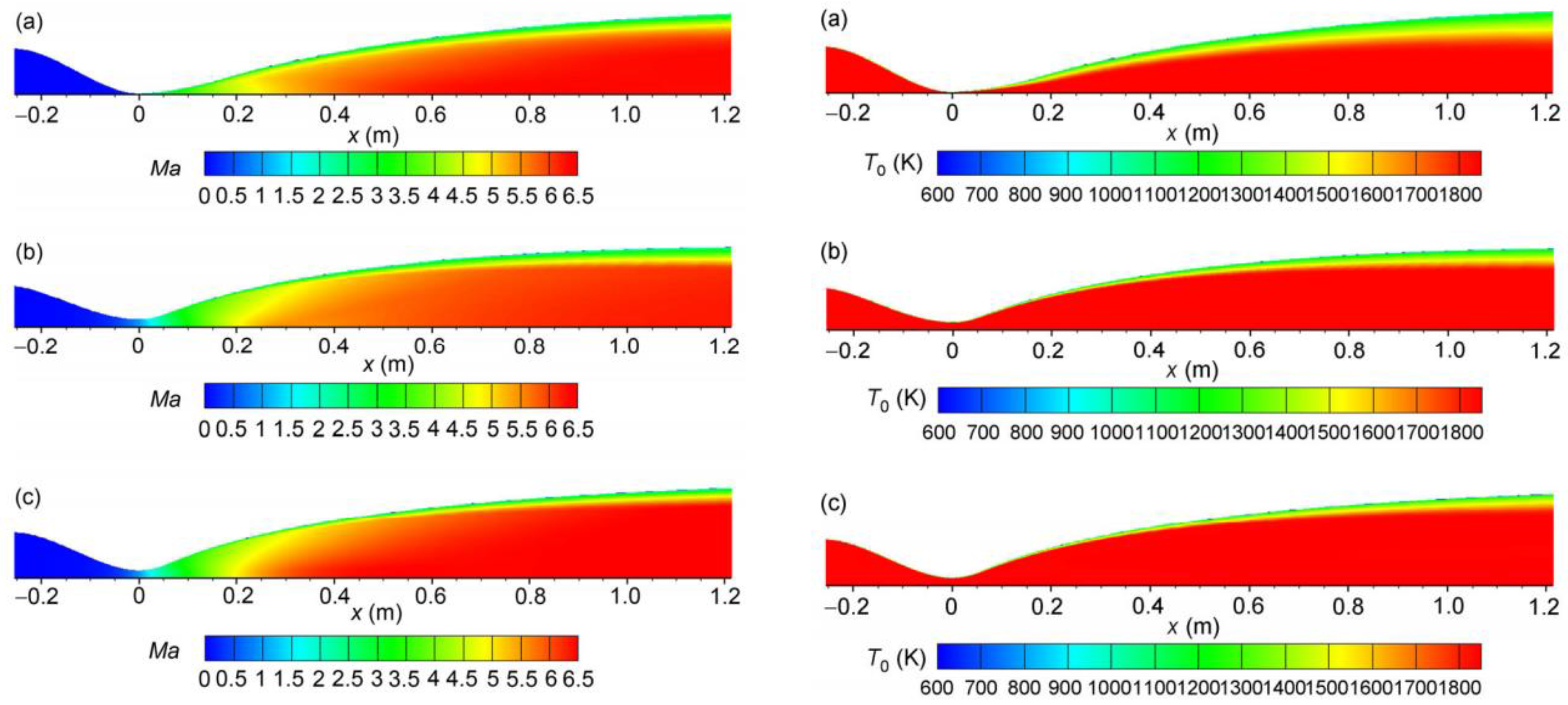
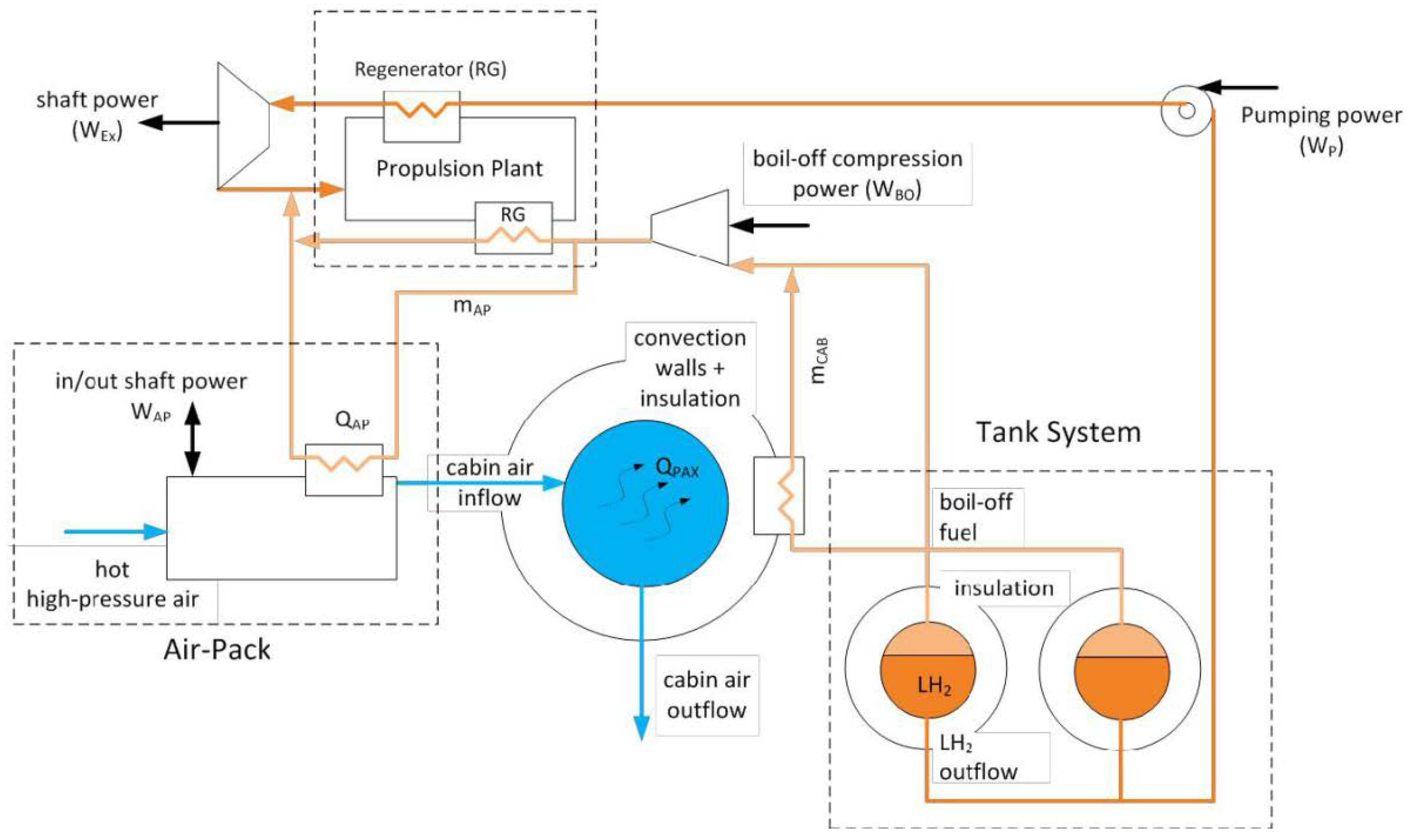
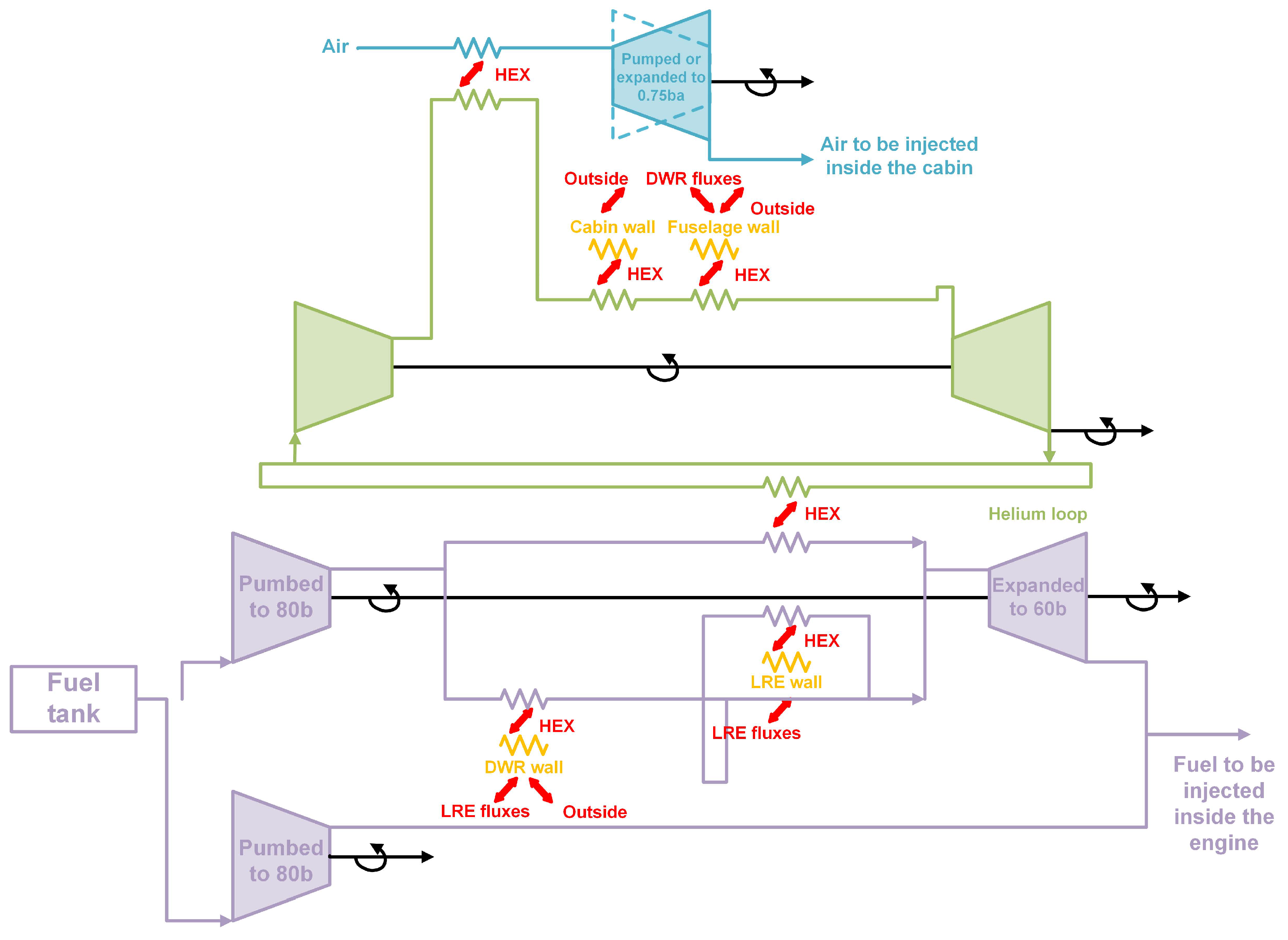
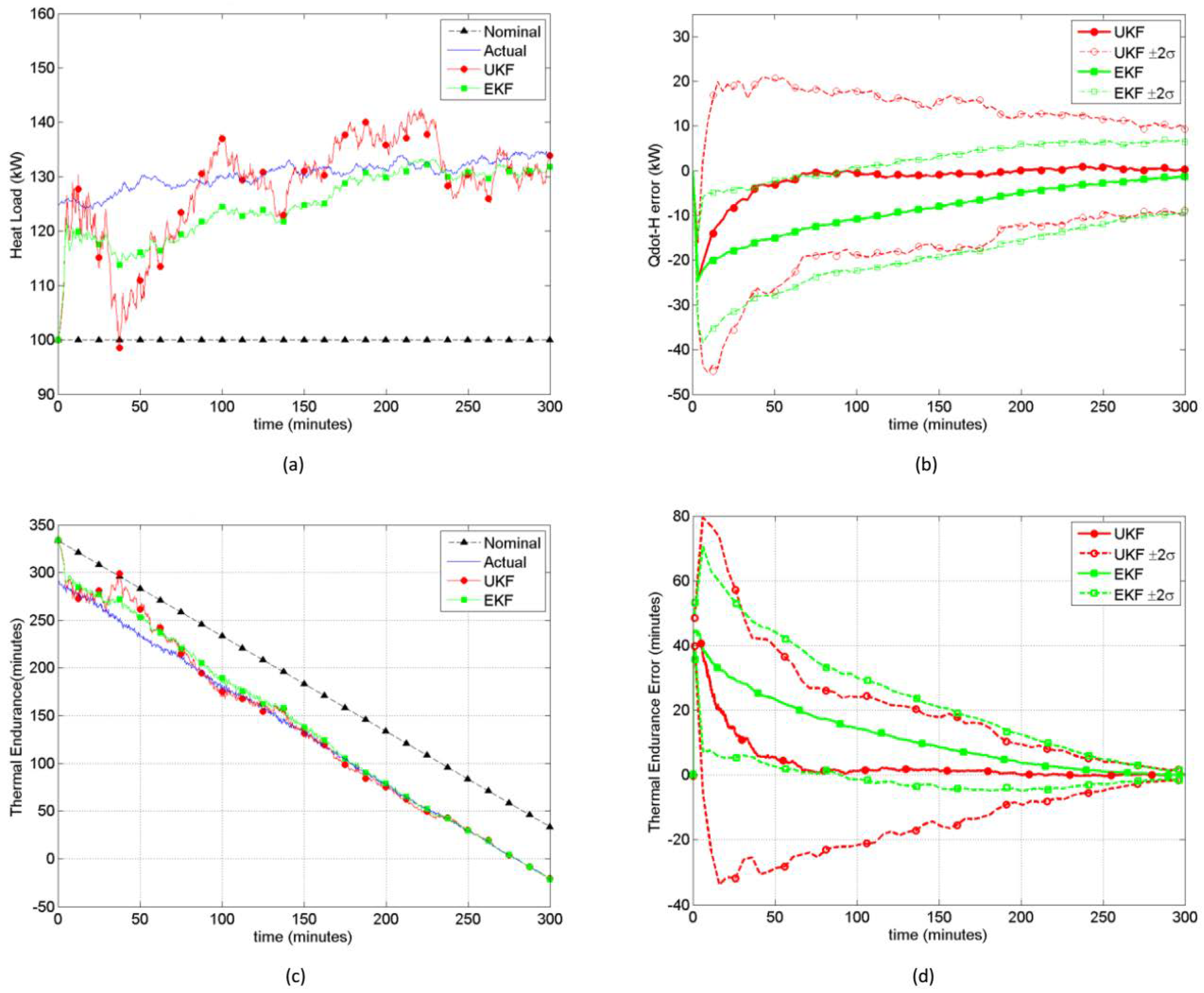

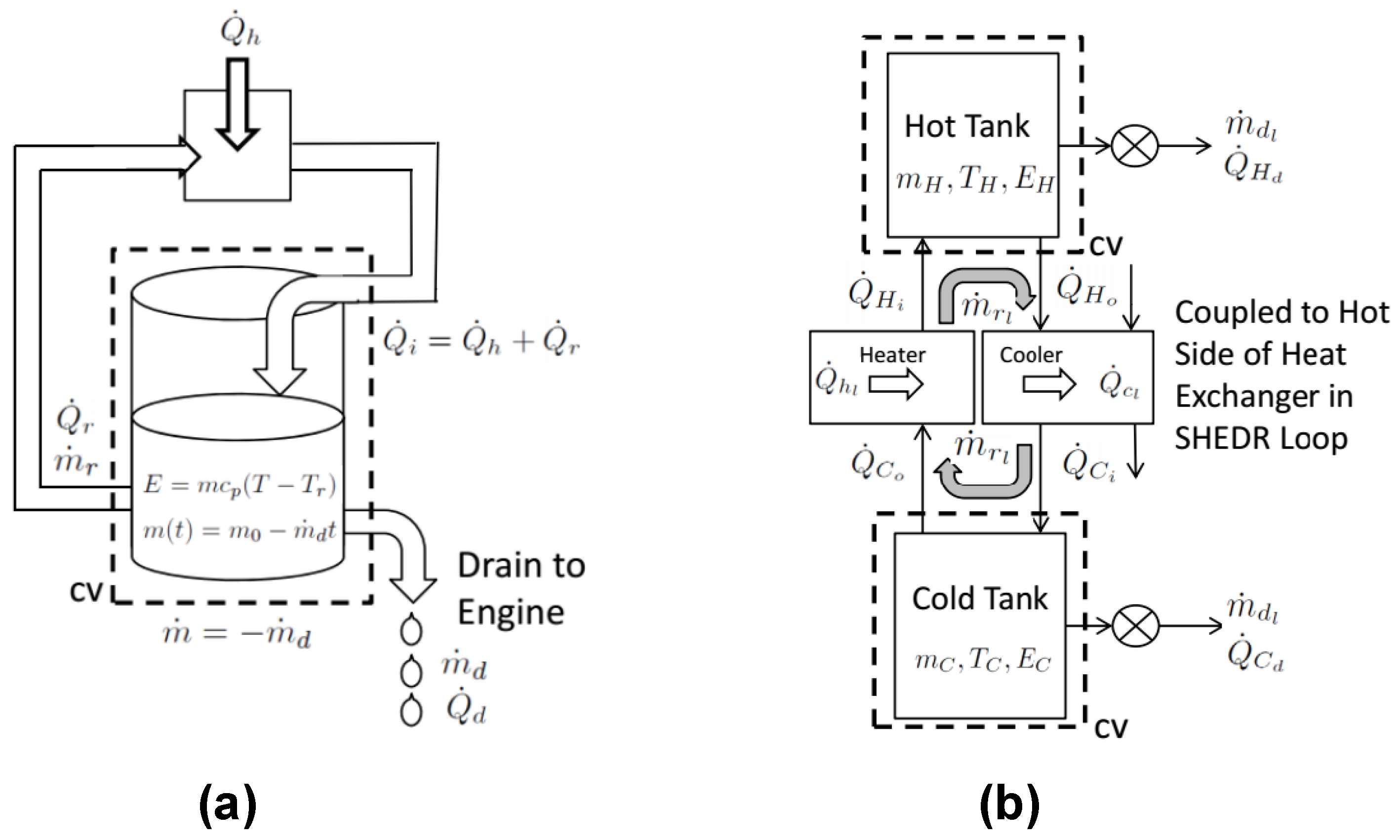
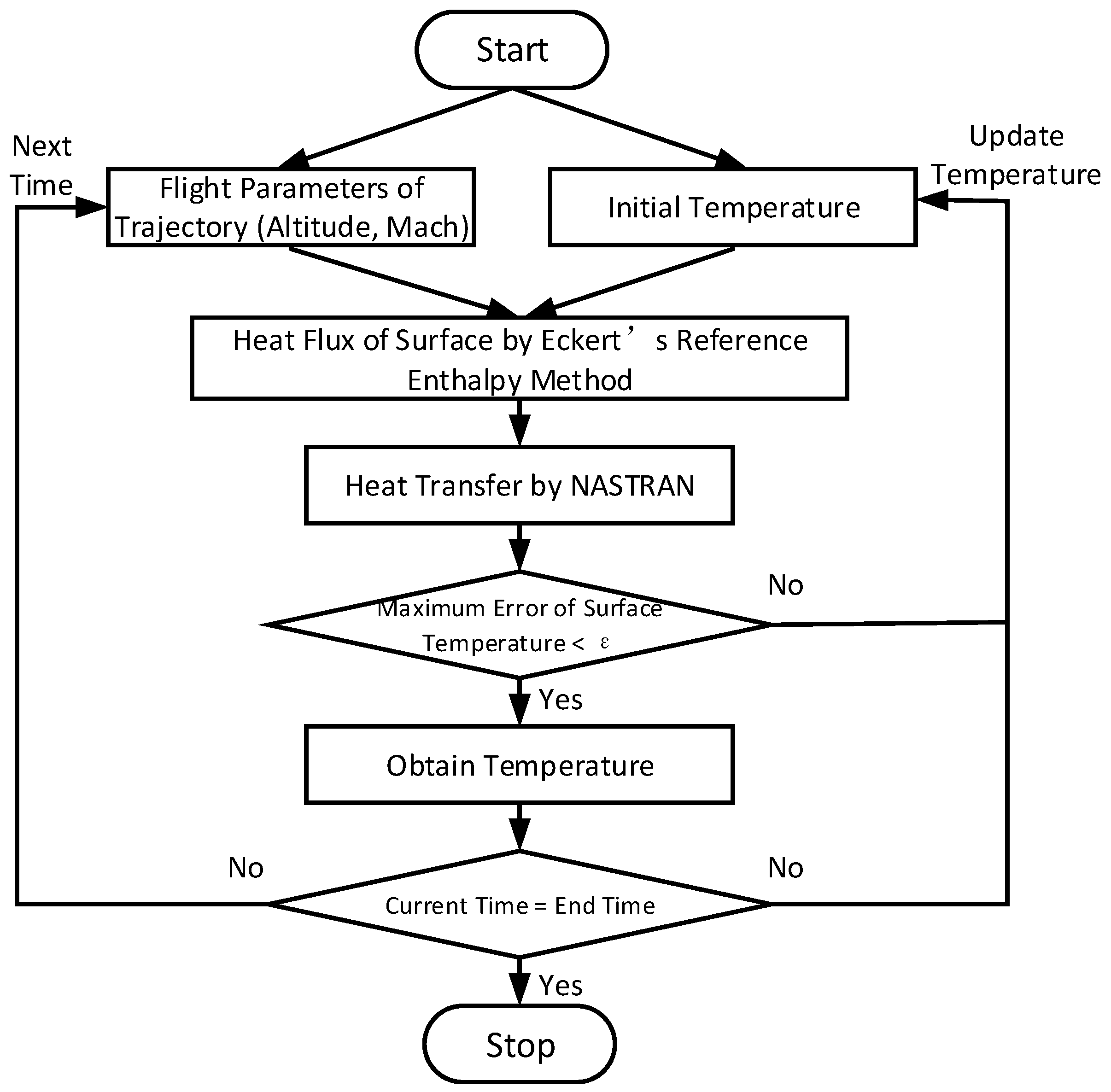



| Notation (mm) | ||
|---|---|---|
| Total thickness | h | 15 |
| Skin thickness (/) | t | 1 |
| Core height | c | 13 |
| Core wall thickness and | 0.3 |
| Combination | Mixture Ratio | Chamber Pressure (PSI) | Vacuum Isp (Seconds) |
|---|---|---|---|
| Lox-Hydrogen | 6 | 1000 | 457.0 |
| H2O2-Kerosene | 7 | 1000 | 331.0 |
| N2O4-Hydrazine | 1.08 | 1000 | 348.0 |
| AP-HTPB-Al | 5.17 | 1000 | 312.6 |
| AP-HTPB | 2.33 | 1000 | 224.0 |
| LOX-Kerosene | 2.33 | 1000 | 347.0 |
| LOX-Methane | 2.77 | 1000 | 365.0 |
| LOX-Butane | 2.2 | 1000 | 255.0 |
| LOX-Isopropanol | 1.7 | 1000 | 341.0 |
| LOX-Propane | 2.55 | 1000 | 357.0 |
© 2019 by the authors. Licensee MDPI, Basel, Switzerland. This article is an open access article distributed under the terms and conditions of the Creative Commons Attribution (CC BY) license (http://creativecommons.org/licenses/by/4.0/).
Share and Cite
Dong, Y.; Wang, E.; You, Y.; Yin, C.; Wu, Z. Thermal Protection System and Thermal Management for Combined-Cycle Engine: Review and Prospects. Energies 2019, 12, 240. https://doi.org/10.3390/en12020240
Dong Y, Wang E, You Y, Yin C, Wu Z. Thermal Protection System and Thermal Management for Combined-Cycle Engine: Review and Prospects. Energies. 2019; 12(2):240. https://doi.org/10.3390/en12020240
Chicago/Turabian StyleDong, Yiwei, Ertai Wang, Yancheng You, Chunping Yin, and Zongpu Wu. 2019. "Thermal Protection System and Thermal Management for Combined-Cycle Engine: Review and Prospects" Energies 12, no. 2: 240. https://doi.org/10.3390/en12020240
APA StyleDong, Y., Wang, E., You, Y., Yin, C., & Wu, Z. (2019). Thermal Protection System and Thermal Management for Combined-Cycle Engine: Review and Prospects. Energies, 12(2), 240. https://doi.org/10.3390/en12020240






